![[Headline]](../../../technik/sonstige/headtran.gif)
![[Headline]](../../../technik/sonstige/headtran.gif)
The SPIEL 08 Games Convention at Essen / Germany23rd to 26th October 2008![[SPIEL]](../spiel2.jpg)
Prize-Draw winners!Snow Tails ubarose Chicago Express Humphrey Clerx Ghost Stories Primoz Jakelj Agricola Postcard Expansion Hiew Chok Sien Le Havre Cards Thomas Taylor CONGRATULATIONS to all winners!Monday, 20th of October3... 2... 1... Lights on, Camera ready, Micro open... Folks, here is Essen / Germany ! Hello everybody, and once again a warm welcome back to my anual rambling speeches about the news from the games scene here at Essen!  After a lousy summer here in Germany, the convention week seems to favour us with beautiful weather. Having seen the inside of my office for the last time on friday, I am looking forwards to this week of holidays, meeting friends and enjoying new games. 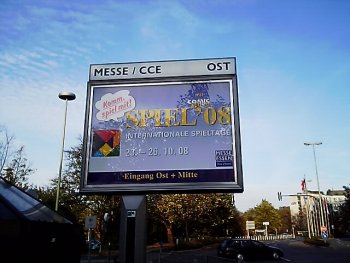 With the every-day life left behind, I sneaked into the convention halls for the first time this year. Being earlier than in last year, I discovered that already quite a few exhibitors have started to arrive.  Especially the major producers with their very large presentation areas need three to four days to prepare everything, and so there wer already good signs of the upcoming convention in Halls 10, 11 and 12.  Even some of the used games traders have already started building up their booths, and the reason for this is that the entrance to the convention halls is much easier on monday than on the following days. Starting on tuesday, trucks only have a time-limited access to the whole area, and they have to leave a high deposit which will be lost if they fail to leave the area within the prescribed time frame. This is different on monday, since they can come in an stay till 10 PM without any restrictions.  Talking about restrictions, I think it a bit fearsome to have a look at the list of new games which is scheduled to be released at this convention. I had checked out lot of games and companies when I started my preparations and schedules for the show, and I feel virtually overwhelmed by the flood of interesting looking games which is bound to arrive this year. It will be rather difficult to determine at which places to look and which games I should present, but once again I am hopeful to offer a somewhat varied cross section of the different games available. A trend from previous years which most of you seemed to favour was that fact that I concentrated very much on small publishers during the convention days, and seeing the announcement for many interesting looking games from smaller publishers I will certainly keep up my special focus on this branch of the game industry. However, G@mebox co-author Ralf Togler will be joining me on thursday, and as it looks like he will put some efforts into creating some daily reports as well, and so we hope to get out a coverage which will be somewhat evenly spread between the smaller and the bigger publishers. 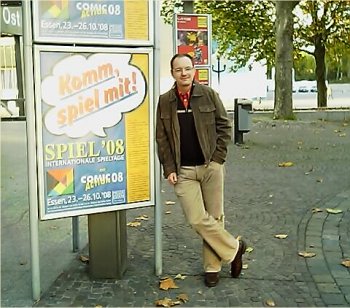 Anyhow, for the time being I am happy to see you all back for the upcoming six days of game reporting. It will be a wearisome time getting these reports to you, but at the same time it is the BEST TIME of the year. And so let me invite you with the anual slogan of the conventionists: "Komm', spiel mit!"(Come and play!)See you soon! Tuesday, 21st of OctoberHello and welcome back for the second day of pre-Spiel reporting! Scanning through my guestbook, I have seen that some of you have followed my reports here from the show for the last decade, and I am happy to see that you find your way back here each year to follow my steps through the convention. This is the 11th time I am giving reports from the show, and the only time when I ever missed the convention was in 1999 when I studied in Newcastle for a year. However, much has changed, and when I started the G@mebox 12 years ago I was running on a very tight server restriction with AOL. My website has grown and my reporting style has changed considerably (although I still do only use four fingers for typing). If you want to remember how it all started do not miss the links at the end of this page which bring you backwards to all the previous reports! Thanks for staying with me for so long!!! And if you want to see how my page looked at the beginning, take your personal timewarp with... 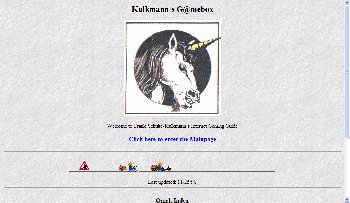 Did I talk about good weather here at Essen yesterday? Hmm, somewhat the reality got back on us, and here we are again with temperatures around 16 degrees Celsius and a nice drizzeling rain. A splendid idea to stay inside some dry convention halls. By the way, perhaps some of you who have visited the SPIEL convention before will have wondered why the subway station in front of the convention halls is names "Messe Gruga". The first part of the name identifies the convention centre, but the second part actually refers to the "GRoße Ruhrländische GArtenbauausstellung", a great gardening exhibition which took place here at Essen in the year 1929 and which resulted in the creation in a very nice, big botanical garden and Park which can be found at the back of the convention area. Many people who have visited the show don't know about this lovely Park, but for people living in the vicinity it is actually much more important than the convention halls. Part of the complex is also the Grugahalle, a place of events for up to 10,000 people. The hall itself is offers a quite extraordinary V-like architecture and it is celebrating its 50th birthday this year.  Anyhow, let us better enter the convention halls before it gets too wet… Entering via the used games area, I saw that the traders had been rather busy the previous evening. Quite a few booths were already assembled, and they now were waiting for the grand opening. 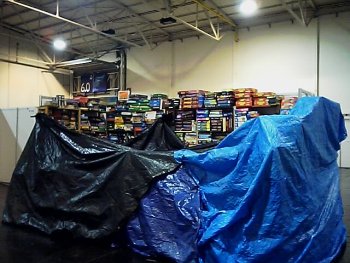 It was rather quiet this morning, but I was early so I took a stroll through the rather empty halls in order to check out which progress had been made on some of the other booths. Also, I checked upon my listing of booth numbers to see whether I got these correct in my schedule for the following days. 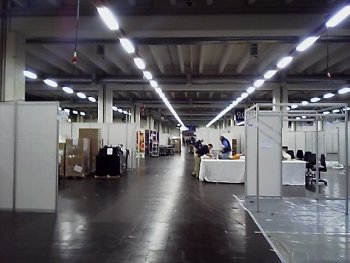 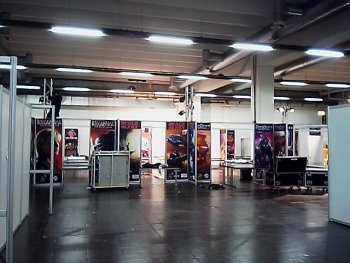 As the morning progressed, work was resumed by the people, and so the booths of a few big publishers also came close to being finished. The interesting part about watching the buildup is that sometimes some graphics from the upcoming games can be seen, giving asome first impressions and ideas were to look. Thus, QUEEN GAMES had a huge advertisement for their new train game Chicago Express on display, a game which I am rather eager to see and play because quite a few good comments had been made on its predecessor Wabash Cannonball. 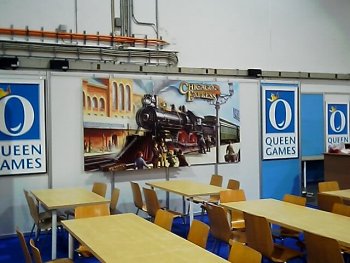 However, one of the best things about the pre-convention tuesdays always is the fact that friends are starting to arrive, and one of the first people I did run into the early afternoon was Dale Yu from Boardgamenews. Meeting him in front of the LOOKOUT GAMES booth were some people were busy sorting expansional cards for Agricola and Le Havre, Dale presented to me one of the first copies of Dominion from RIO GRANDE GAMES. Here in Germany Dominion will be produced by HANS IM GLÜCK, and it is just another game which I will possibly have a closer look at during the following days. 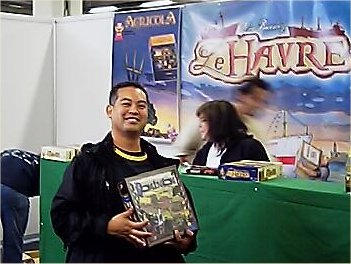 By the way, Uwe Rosenberg seems to have brought quite a few likely and unlikely Agricola-items to Essen. Apart from the new cards which were sorted at the booth I have also seem a new mini-expansion on a postcard, a poker-deck, and even some caskets with the refreshing "Agri-Cola" now were being delivered. It's quite funny to see what kind of attention this game has created! The next booth I went by was AllGames4You, a local gamestore which is run by Heinz Thiemann who is the author of the upcoming LUDOART game Planet Steam. Heinz and I talked a bit about the game since I did not find the time to have a closer look at the rules before the convention, and he announced that the roots of Planet Steam actually go back about 20 years to an old computer game for the Commodore 64. The game was called M.U.L.E., and it was a game for four players which I remember quite well. It had an unique possibility that all four players could act simultaneously (remember, that was well before the time of the Internet or LAN!), and it was a great strategy game. Also pre-convention reports have stated different numbers, Planet Steam will be released in an initial edition of 500 copies which will be sold at a price somewhere around 70 Euros. Over 100 copies of the game have been pre-ordered, so it will be interesting to see how fast the game will be sold. 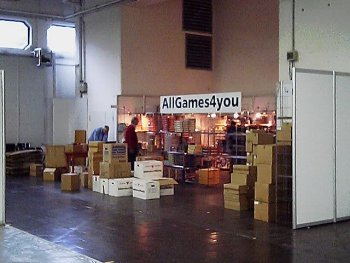 As the afternoon went by, even more people started to arrive, and so I cam upon the Finnish publisher TUONELA which I had presented to you during my reports last year. It has been a good year in between for Jussi Autio and his crew, and his first game The Club actually has found an American distributor so that it has become the first game from Finland to be sold at other continents. This has created some good publicity for TUONELA back in Finland so that Jussi has brought several new prototypes and the finished version of last year's Modern Society to Essen. 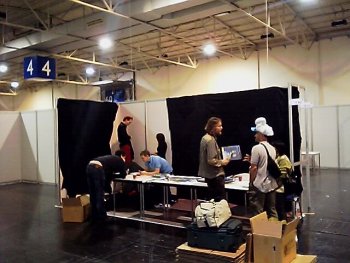 To finish the day, I went to the booth of my favourite Scotsmen, and there I found Frazer Lamont and his wife unpacking the first copies of Snow Tails, their new game about dogsled racing. And having told the Lamont brothers about the great participation my Antler Island prize-draw has found last year, I was happy to secure a copy of Snow Tails for this year's… Prize-Draw!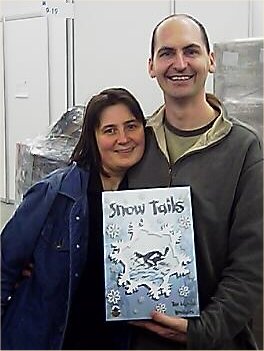 Once again, the Lamont family has sponsored a copy of their brand-new game Snow Tails, and all you have to do to enter the prize-draw is to sign my SPIEL Guestbook ! As always, some more prizes may come in the following days… Well, that's it for today. Tomorrow the whole convention will pick up movement with the Press Conference and the awards ceremony for the "Deutscher Spiele Preis". See you soon! Wednesday, 22nd of OctoberHi again everybody! Today was the final day before the convention opens its gates for the public at large, but taking my usual morning stroll I could certainly discover that much progress has been made and once again the halls were getting ready for the crowds.   At 11 AM finally the first official action of the convention started, and once again several hundreds of journalists from many different media were streaming into the Press Center to attend the Press Conference. 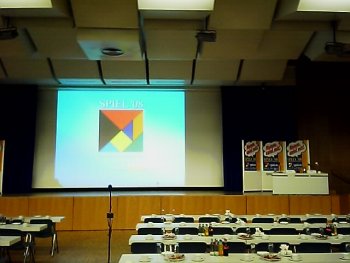 As in previous years the conference was headed by Mrs. Dominique Metzler from the Merz Verlag, and she brought to our attention the bare by nonetheless impressive facts of this year's convention. With 760 participating exhibitors the SPIEL 08 once again has set a new record, and never has the participation of foreign publishers been higher. 41 percent of all exhibitors are coming from foreign countries, and whereas in former years nearly all of the foreign publishers came from Europe and the USA, this year has seen a considerable rise in publishers from Asia and Australia. In this context it is quite remarkable that the Korean government actually has sponsored a 100 square meters pavilion in which five different boardgames from Korea are presented. These games were the winners of an official games contest in Korea, and as a result the creators were given the possibility to present their games here at Essen. Also, the number of new games to be presented at the SPIEL this year has risen considerably. In 2007 about 450 new games were presented at the convention, but this year over 550 new games are available. No wonder that I feel so dizzy when it comes to the decision which games I should present. After Mrs. Metzler the moderation was taken over by Mr. Hopf, the new speaker of the German games industry. Mrs. Hopf confirmed the trend that especially the export of games has cause a rise in the sales numbers in the previous 12 months, and whereas some years ago it would not have seemed possible countries like Japan and Korea now have started massively to order games from Germany. Mr. Hopf confirmed this trend especially for his own brand, the children's games producer HABA. Today, HABA is exporting about 50 % of their production. However, he ended his presentation by pointing out that despite the general strong positioning of games every boom must come to an end sooner or later, and so the sales numbers of Poker games and accessories finally have dropped. All interested households now have a Poker game, so that the market is saturated. After the Press Conference the News Show opened, and this usually is a perfect opportunity to have a look at most of the new games and to chat with a few representatives from the different gaming companies. A big booth right at the beginning usually is reserved for the winner of the Deutscher Spiele Preis, and so Hanno Girke and some other people from LOOKOUT GAMES were effectively demonstrating how people must have played Agricola in the Middle Ages. 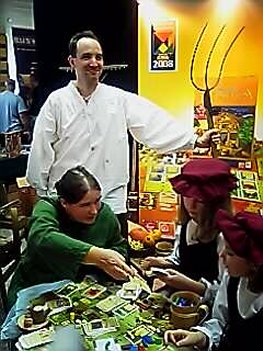 One thing at the News Show really captured my eye, and this was the booth of NEXUS GAMES from Italy were the mystic and much debated box for the War of the Ring Deluxe Collector's Edition was displayed. 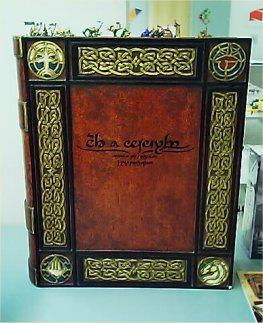 The new edition will come in a huge and beautiful wooden box, shaped as a book with a few carvings and an Elven inscription on the front lid. But for those of you who are getting their hopes up: the game still will not be available this year, but NEXUS is planning on releasing it in Spring 2009. Actually, there exists a subsection of the German pages of PHALANX GAMES where the game can be pre-ordered (!!!), and there it is stated that the Deluxe edition will be limited to 200 copies and will costs 199 Euros. 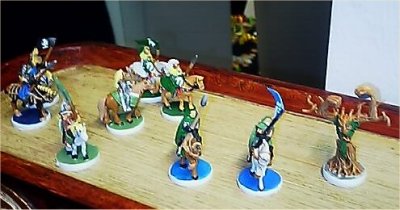 However, I must confess that I was a bit disappointed by the painting of the playing pieces. Whereas the box is marvellous, the playing pieces are rather colourful and to my mind especially the bases where give some strange colours. This might have been done to distinguish better between the different races, but to my taste the colours are a bit off. The pictures below are the best I could get with my simple camera, but they are at least some indication. 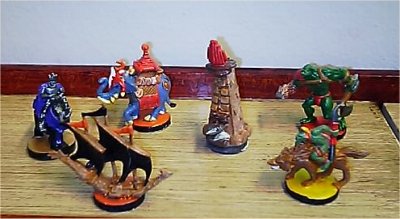 Also on display was the German version of Dominion by HANS IM GLÜCK, a game which has received much attention in the days and weeks before the convention. I shuffled a bit through the cards, and despite the fact that quite several hundred playing cards are included there exists quite a few cards which are available in multiple printings, effectively giving the players a chance to learn the game without knowing hundreds of different cards. But as Dale Yu pointed out to me yesterday, there is quite enough room for expansions of the game. 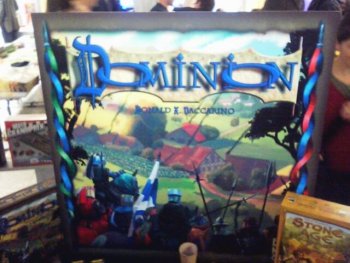 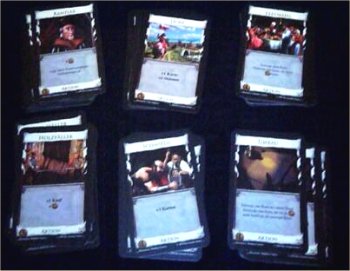 Finally, I was able to see the new edition of Risk Deluxe for the first time. The game has been given some decisive changes after HASBRO had invited fans and players to give advice how to improve the game, and a few of the suggestions which were sent through a special webpage had resulted in the new set of rules. I was able to test the new rules because I had received a copy of the press-only Risk - Black Ops edition several months ahead of the show, and now I was able to see the new game for the first time. The design has left the Napoleonic age and has been re-structured to fit modern times, but I somehow miss the cannons and cavalry from the previous Deluxe edition. The armies now were exchanged for different sized arrows to give the whole game a command-room look, but myself I liked the old design better. 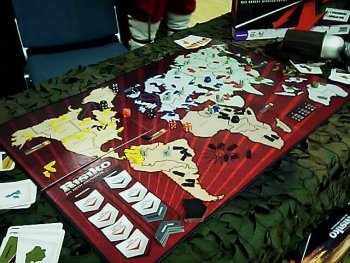 Over the afternoon people were doing the final preparations to their booths, and the convention area was getting ready for the masses to come.However, my day was not over yet, and in the evening I visited the formal dinner which was associated with the awards ceremony for the Deutscher Spiele Preis. Year after year, a great crowd of games authors, publishers and journalists is invited to the event, and the evening always is a perfect time to chill out a bit before the convention starts. 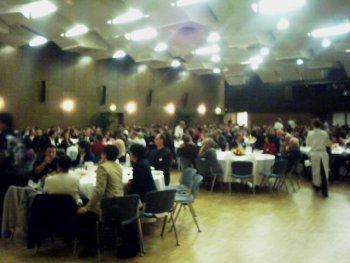 As indicated above, the winner of the Deutscher Spiele Preis 2008 is ACRICOLA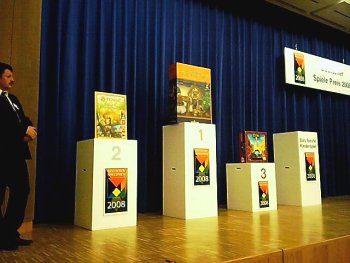 As Uwe pointed out in the Interview with Mrs. Metzler, this has led to the creation of a game which had inspired him greatly and which had been designed exactly as he wanted it to be. As he said, Agricola has become his favourite game not only as an author but also as a player, and he was quite certain that, if he would be asked in 10 years for his favourite game he would still answer it to be Agricola. 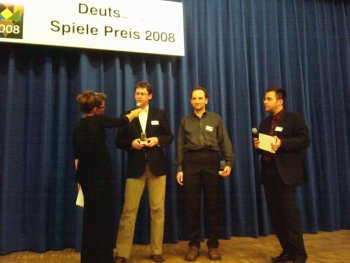 Second came once again a game from HANS IM GLÜCK which has been one of the most successful publishers, and I think that Stone Age is a game which certainly does not need to fear a comparison with Agricola in terms of playability or general attractiveness.  The third place finally was given to Cuba by Peter Eggert, and together these three winners once again have shown that the Deutscher Spiele Preis certainly is an awards for people who play often, whereas the Spiel des Jahres (with its winner Keltis ranking on 8th rank here) is an awards for the public in general and the occasional gamers.  The Deutscher Kinderspielepreis finally saw star-author Rainer Knizia (the Ghost!) enter the stage once again to receive the awards for his electronic boardgame Wer war's?, and during the interview it was stated that, after the somewhat meagre success of King Arthur and Die Insel RAVENSBURGER now was quite happy with the unification of a boardgame with modern technology. They are going to explore the possibilities of this even further. 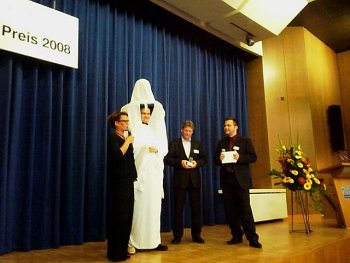 Finally, the Essener Feder awards for the best-written rulebook went to GAMEWORX for their game Jamaica in which the rules are presented like a treasure map. While this way of presenting the rules certainly is quite innovative, I am not sure whether it actually really helps to get an overview, but at least it matched the high articstic degree which was given not only to the design of the game but also to components like box and rules. 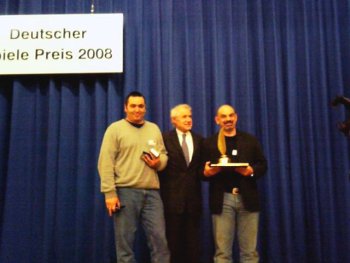 Anyhow, this finally ended the evening for me, and after a nice dinner I went home to get all this typed for you. Tomorrow you will finally hear some more details about new games, so be back here for the first day of the real show!!!  Thursday, 23rd of OctoberAnd here we go! The 26th SPIEL convention has opened its gates today, and once again thousands and thousands of gamers from all over the world have invaded the formerly quiet convention area and turned it into a buzzing beehive of gamesfreaks. As usual, long queues had formed in front of the entrances well before the opening hour, and once the doors were open a seemingly endless stream of people came in and quickly occupied the playing tables all over the halls. 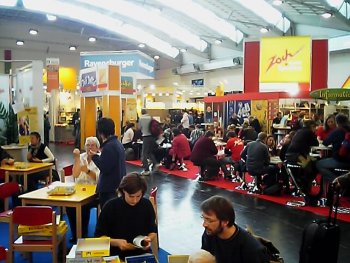 I had chosen the first game to check out well ahead of the convention, because the first images I have seen looked rather promising and its author actually runs the best stocked games-hobby-store here at Essen. I am talking here about Heinz Thiemann, who had succeeded in getting is first game Planet Steam placed with the publisher LUDOART which is well know for its lavishly equipped games. 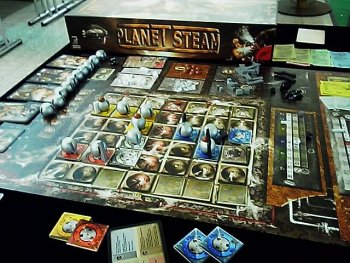 I was expecting all testing tables to be taken rather quick, and so I arrived quite early to ensure a place for a testing round. And indeed, people were filling the table in a matter of moments once the halls were open, and even more interesting the big rectangular box containing Planet Steam was selling rather well. Even while I played quite a few copies were sold (at a price of 60 Euros), and considering the fact that the game has been manufactured in an initial edition of 500 pieces it is well possible that the game will be sold out during the convention. Now turning the game itself. The big box showed up to contain an even bigger set of gameboards, coupled with loots of wooden pieces (steam tanks, pipes, resources), stones and cards. As a background story, the game is concerned with the production and selling of resources on another planet, and the player who will organise his industry most successful will have won the game. Each player receives some resources (stored in spaceships with limited storage room) and money as starting capital, and the first and each following round of play then starts with an auction of different characters. In a five-player game all five characters participate, and so the players may enlist the help of a Surveyor, a Constructor, a Steam Regulator, an Agent or the charismatic Lady Steam for the upcoming round. Each player will receive a character, and the characters not only offer several special abilities but they also will determine the playing order in each phase of the round. The privilege of being the first player in each action goes to the Lady Steam player, and a round then starts with the Surveyor chosing an engine place for auction, and apart from the two engine spaces which each player possesses at the start of the game the players slowly will start to acquire more engine spaces since they want to place the steam tanks which are the centrepieces of each player's production. The players now may bid for the space, and here the price of the engine space will be depending on several factors. So, the central row of spaces of the whole engine area is of special interest because water can be produced there just with bare steam tanks, and also it is also in the interest of the players to get engine spaces neighbouring their own engine spaces since steam tanks on adjacent spaces can profit from synergy effects during the production phase. When the auction for the chosen space is over (and paid for), all players have a chance to acquire an engine space as well, but here a dice needs to be rolled to determine whether the desired space can be taken. Thus, the Surveyor conveys the benefit of choosing a space for auction directly, and if his player should win the auction he only needs to pay half his bid. The Constructor also brings a benefit here because he has access to deeds which allow him to chose an engine space as well. Next comes the building phase in which the players may purchase steam tanks and equip them with the piping or production equipment needed to produce the different kinds of resources. The purchased tanks and equipment is placed on the engine spaces and thus are available for the next production phase. Also available are larger spaceships, and here the Agent can use his benefit either to upgrade one of his spaceships for free or to receive a free resource. All building operations are paid for with Credits and certain resources, so the players have to make sure that they have the right resources to build. In the production phase the players then will use their steam tanks to get new resources, and here the Steam Regulator determines which row of spaces in the engine area will receive extra steam so that the production of any steam tank in this row will be doubled this turn. A water resources has to be paid to get the production of each steam tank going (with the exception of the tanks on the center row where water is produces for free), and then all players collect the resources they have created this turn. These need to be stored in the spaceships, and any excess resources which cannot be stored are lost. The round then is finished with the trading phase, and here a nice, sophisticated market mechanism comes to bear through a store board and a price board. The storage of each resource on the planet increases and decreases with every buying and selling action of the players, and this leads to adjustments of the current price of each resource so that the market situation is represented quite well. On the market especially the black crystals fetch good prices, but the other resources (Water, Energy, Ore) are needed as well in order to keep the production going. Of course there is quite are quite a few more twists and rules in a game of this size and context than could be given in this short overview, but nonetheless this should be sufficient to give you a basic outline of the game, While playing I got the impression that not only the components but also the playing mechanisms in this resource management game have been created in a purist but quite elegant way. Especially the market mechanism was integrated quite harmoniously and without the need to do any major calculations, so that the game keeps going quite smoothly once the players have understood the basic mechanics of production. As promised, virtually no luck influences this game, so that in the end the production process will be dominated by the player who makes best use of his available resources. Afterwards, my personal reinforcements arrived, and I went to meet G@mebox co-author Ralf Togler who will join my efforts of reporting some of the news this year. I went to meet him and to exchange notes and schedules, and once we had agreed how to spread a bit of the coverage we both went our ways in search of prey.  Sometimes the SPIEL convention produces its own trends, and one thing which was deemed to happen this year was that big queues were scheduled to be found at the booth of LOOKOUT GAMES and SPLOTTER SPELLEN. I passed by the SPLOTTER SPELLEN booth on my way for the next game to test, and here I found out that the 200 pieces of Duck Dealer which they had brought to Essen must have been sold out in a matter of minutes. 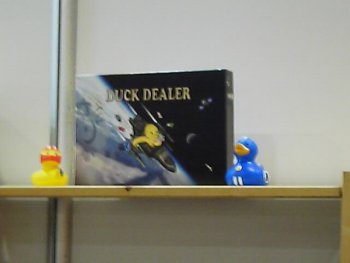 However, I still saw a game on display, and giving the playing material a closer scrutiny I decided that I must have seen a game which was still a prototype because otherwise I honestly could not understand why loads of people had spent 60 Euros to get this game. Okay, the cover art of the game looked promising and I definitely cannot judge the rules so this might sound a bit prejudiced, but if it has been the finished game which you see on the picture below then the whole graphic layout looked like it needed to be warped into present times. True, a game needs good mechanics better than smashing graphics, but modern possibilities to design game have reached many small publishers… 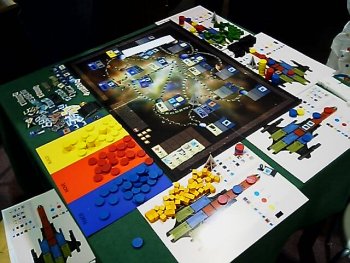 This actually brings me to my main coverage area of the day, because I thought it would be a nice idea to put a special focus today on some games which were bought to Essen by producers from Eastern European Countries. Over the last few years publishers like CZECH BOARD GAMES or CZECH GAMES EDITION had become quite popular, and thus the number of exhibitors from Eastern European Countries has increased considerably. So I first went to the booth of WOLF FANG, a Polish newcomer which is present at the SPIEL for the first time, and among the games they had brought with them I could find the rather promising looking game Yucatan. 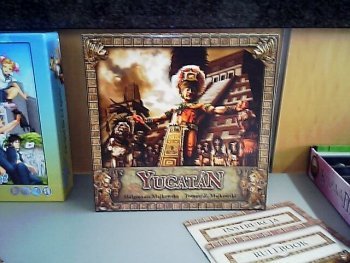 The author Marcin Posiadlo takes the players back to the time when Aztek civilizations were living and the jungles of Central Amerika and constructed magnificient pyramids, and thus it is the aim of the players in Yucatan to be the first to finish a great pyramid. In order to build new levels of a Pyramid a player needs slaves, and for each three units of slaves which have been brought either to a players capital city or one of his major villages the player may chose to add a level to his pyramid. In total, each pyramid consists of five levels, and the first player to finish the fifth level will be declared to be the winner of the game. 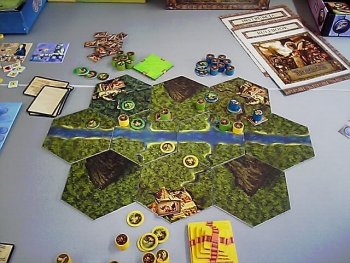 Before the game begins, the gameboard is set up with a number of hexagonal tiles which feature an even finer gridwork of hexagonal spaces. The gameboard may be set up freely, including mountains, small rivers and a major river, but for beginners it is recommended to follow a fixed setup which is suggested in the gameboard. The hexagonal tiles also feature spaces with the capital cities of the players so that these will not be placed separately, but when the playing area is ready the players will take turns to add a major village and a small village to the gameboard. Also, some neutral small villages will be added by each player. Some placement rules must be observed here, so that a any kinds of settlements may not be located on neighbouring spaces, and also the positioning next to a river may give a player access to different spaces. Finally, each player places two warrior tokens next to his capital. These tokens represent a group of warriors which has either the Jaguar, the Snake or the Hummingbird as their Totem, but the totem of the placed warriors is not revealed to the other players. Each player possesses three warrior tokens of each Totem, so that the two tokens placed at the beginning of the game may follow either the same or different Totems. The game takes a rather aggressive stance right from the beginning since it will be the aim of the players to "recruit" new slaves either by defeating opposing warriors or by sacking foreign villages. The latter option is more easy, since a player just needs to move one Warrior token into an opposing village and declare that village to be sacked. Now a slaves token is placed under the warriors of the aggressor, and if the plundered village was large it will be downgraded to a small village. Otherwise, a plundered small village will be destroyed in removed from the gameboard. However, the players are looking jealously after their villages, since a player always only may possess as many warrior tokens as he has villages (plus one for the Capital city). Thus, to prevent a removal of warrior tokens just by the loss of villages and to get the possibility to gain slaves themselves, players will move warrior tokens of their own into either aggressive or defensive positions so that sooner or later two tokens may meet each other to combat. The outcome of a combat is determined quite easily, since a fixed order is given how the groups of the different Totems will beat each other. Both players participating in a combat will show the Totems of their groups to all players, and then the Jaguar will defeat the Snake, the Snake the Hummingbird and the Hummingbird will defeat the Jaguar. In case of equal Totems the victory will go to the defender. The defeated warriors will be instantly removed from the gameboard and the victorious player now is allowed to place a slaves token under his warriors. Warrior tokens may be used for different purposes like guarding villages, attacking and escorting slaves back to a player's city, but an important other function is that they may spend a turn to construct a new village. This gives a player access to additional warrior tokens, but all the placement rules from the preparation phase of the game need to be observed. As said, a player will receive one pyramid-level for each three groups of slaves he escorts back to his city, and the game is won by the player who first has finished the last part. Yucatan first captures a player's eye by the nice design of the playing pieces and the wooden multi-part pyramids, but even in terms of gameplay the newcomer WOLF FANG succeeds in keeping up with the general good impression. While it is true that Yucatan offers no really new rules but instead a mixture of features which could be discovered in one game or another, the composition of the whole product is very harmonious and creates a nice playing experience. Talking to other people, it seems that the cover and design of the game actually suggests a considerable playing depth, but I would rate the game's complexity to be on level with average family games. No deep structure which needs a lot of calculation, but some nice elements of memory when it comes to discovering the nature of enemy warriors. Before I could go on to the next testing session I first had to keep a press date with a representative from HASBRO, and I was eager to see whether they had once again brought a new prototype of the PARKER series of author's games to Essen. Here it was rather disappointing to hear the news that HASBRO has decided to cancel this series (the first three titles were Tal der Abenteuerer, Origo and Deukalion) because the sales numbers did not get to a dimension which would have seemed acceptable for a market giant. As indicated three years ago HASBRO had been hopeful to get a chance at a German games award with one of these games, but this hopes had been futile and so the series has ben cancelled. Personally, I think that this had been too quick a decision, since especially Deukalion made me hopeful that they were slowly growing an interesting branch of family games with a touch of complexity. However, strangely enough it seems that bigger companies sometimes have less time and will to wait than a smaller publisher would have. Taking a shortcut over one of the inner courtyards, a saw that the good weather had returned, and just like in previous years players were stopping outside for taking a break or even to play a game - depsite the somewhat colder temperatures.  Most of you will have stumbled upon my huge Talisman section over the past years, and thus you can understand my interest whenever I see a new fantasy adventure boardgame being presented. Passing the booth of CZECH BOARD GAMES, I decided to give the nicely looking Dorn a try in order to see whether this once again could be a reason to dare some voyages within dark dungeons. 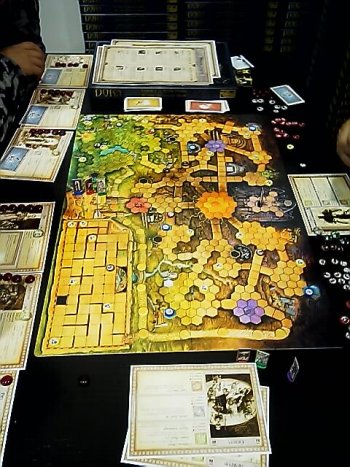 Like in traditional Heroquest, the game Dorn sees a band of five Heroes (controlled by one or more players) take on a quest against the evil Dornkeeper Zorkal who plans to destroy the peaceful hamlet of Argos. The map of Dorn shows a huge dungeon in the centre of which the sealed Throne-room of Zorkal can be found, but also some additional areas like the Black Moor or the Sewers exist. The gameboard is set up by placing several dozens of treasure tokens, some weaker monsters and six artefacts on prescribed positions, while the figures of the Heroes are placed in Argos and Zorkal in his Throne-room. The playing sheet of each of the Heroes lists the basic attributes of Hit-points, his movement allowance and the number of attacks he can deal in a turn, and also several special attributes are described which allow each Hero to perform some special actions. The characteristics part of each character sheet is split into three parts, and as the game progresses the Heroes may rise to second and third level, and at each level increased characteristics and new additional special skills will apply. As Zorkal is present on the gameboard as a character, he possesses a playing sheet as well and has attributes similar to those of the Heroes. During his turn, Zorkal will move his monsters on the gameboard and he will try to get them into position to fight the the Heroes in the different areas of the gameboard. Unlike many other adventure games, Dorn does not use any dice to determine the outcome of a combat, but instead each attack dealt by a Hero or a monster normally deals one point of damage. A Hero can parry the first attack directed against him each turn, whereas the weaker monsters will be killed just after they have received one hit. The stronger monsters on the other hand can withstand one hit and will be turned on their backside when they have been wounded. Killed monsters are kept by the Heroes as a sign of gathering experience, and once a certain amount of experience has been gained they will be allowed to rise a level, giving them access to more attacks, a higher Hit points maximum and additional skills. Zorkal on the other hand will collect blood tokens the Heroes had to discard because they have been wounded, and these blood tokens will be used by Zorkal to play Dark Ritual cards which will increase the abilities of his monsters or cause some other dark effects. Likewise, Zorkal can keep and collect these blood tokens instead of performing a ritual, and then he can use them for rising a level of his own. On their quest through the dungeon the Heroes will come upon a number of treasure tokens which were placed at the beginning the game, and the finding of such a token enabled a player to draw a treasure card which in most cases will bring him some kind of benefit. However, of more crucial importance for the Heroes' quest are the artifact tokens which were also distributed, since the Heroes must succeed to get three of these tokens and take them to the Ritual Chamber in front of Zorkal's Throne-room. Only if three artifacts are present in this room the seal to the Gate of Doom will be broken and the Throne-room may be entered. This effectively frees Zorkal, and if his Minions should succeed in driving the Heroes back before they can finish their task by killing the Necromancer, he will now be free to roam through the Dungeon and try to get the Heroes into single combat. However, of even more importance for Zorkal is the performance of the Ultimate Ritual. This ritual is performed by filling all the spaces in the Ritual Chamber with a total of 19 monsters for three consecutive turns, and if the Heroes cannot prevent this sacrifice the village of Argos will be doomed and the Heroes have lost the game. The game is spiced up by a manageable number of additional rules like ranged weapons, or Pikes, monster abilities and special healing places, but despite the familiar sound all these elements might have there exists a number of rules which set the game apart from many other Dungeon-games I have played. As said above, one of the major differences between Dorn and games like Heroquest or Talisman is the total absence of dice in combat, and this actually adds a nice strategic dimension to the game because the players need to think how to positions themselves when facing Zorkal's hordes. Getting into an advantageous positions becomes vitally important, because otherwise a group of monsters has a good chance to defeat a Hero. What I like even more is the fact that the Dungeonkeeper actually is present as a character and not just a dark force controlling everything bad and ugly. This increases the playing fun of the player who has to impersonate the bad guy, since it takes the whole matter of the final battle between himself and the Heroes to a much more personal level. That's a much more interesting ending than just by defeating a bunch of monsters by rolling the dice. The gameboard features inside and outside areas, and this actually adds to the playing fun as well because the Heroes are not just restricted to some dark cellars, and so they have an interesting world to explore. Some parts of this world may be lost if Zorkal's hordes get too strong, and this will force the players to think about other ways how to acquire the needed three artefacts. Just four pages of rules, a colourful gameboard and slender pencilled character artwork make up the basis for a rather interesting adventure game, and to me this game is another splendid example for the hoard of creativity which can be found with the freshly awakened game designers from Eastern Europe. Talking about Poland, I had scheduled a testing round for the game Krakow 1325. While the author and publisher Peter Struijf actually is located in the Netherlands, the game actually takes us back to medieval Poland for a struggle for predomination in the capital city. Arriving at the booth of GEODE GAMES, I found the Valerie Putnam and Dale Yu from Boardgamenews also had booked for this demonstration round, and so the three of us joined Peter for this four-player game. 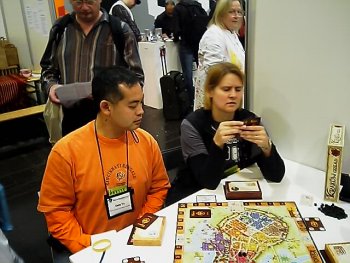 Krakow 1325 AD is a round-based cardgame in which the four players compete for influence in medieval Krakow. At the beginning of the game each player will be assigned a secret identity which he will keep hidden for the duration of the game, and also the players will be divided into two teams with the team partners sitting on opposite sides of the table. Depending on the available time, the game will be played over a duration from one to three years, and in each year the four seasons and the year's end phases will be played. At the beginning of a year cards of the four seasons will be shuffled and one card is distributed to each player to have a start player for each season. After this, the year starts with Spring and now a deck of Intrigue cards is shuffled and a hand of 9 cards is dealt to each player. The cards of the Intrigue-deck belong to one of the four different factions which want to rise in power, and these factions are the Citizens, the Clergy, the Secret Societies and the Underworld. Each of the cards has an opening value, and this value will come to bear when a player choses to play such card at the beginning of a round of cardplay. After the start player has chosen an Intrigue card and has played it, the other three players in order will have a chance to either strengthen the power of the Intrigue or to fight against it. For this reason, each Intrigue card shows colour-coded boxes matching the colours of the four factions, and each card features both a positive and a negative modificator for each colour. The Team partner of the start player will have to chose one of his own Intrigue cards and then applies the positive modificator of the colour matching the card played by the start player, whereas the two players from the opposing team will apply the negative modificators of the respective colour. When all four players have played their cards, it will be determined whether the Intrigue was successful by adding up the opening value of the first card and the positive modificator of the team partner's card and then substracting the negative modificators of the cards played by the members of the opposite team. If a positive value remains the Intrigue was successful, whereas a negative result means that the opposite team succeeded and preventing the Intrigue. Whereas the successful prevention of an Intrigue just means that the right to play the next opening card switches to the succesful team, the succesful playing of an Intrigue will give the players influence in the different districts of Krakow. Here the gameboard comes into play, showing the seven different parts of the city of Krakow, and each part of the city features a bar of 8 boxes for influence tokens in four categories: Fame, Followers, Power and Money. The players who have won their Intrigue now refers to the Intrigue card, and the card will be shown in which district they may add influence tokens on which bars. Regardless to which of the foru bars of a district the tokens are added, only tokens of the team's colour (black or white) are used on the four bars. However, money has a special purpose and it will not be placed within the city district but is goes to a player's treasure chest. Finally, the successful Intrigue card will be placed face-down on a designated pile. After this, a new round is started by playing a new Intrigue card, and once again the teams will compete either to assist or oppose this new Intrigue. The game continues this way until seven rounds have been played. Now the players will discard the final two Intrigue cards from their hands and they will be dealt a new hand of 9 Intrigue cards. This marks the beginning of the next season. 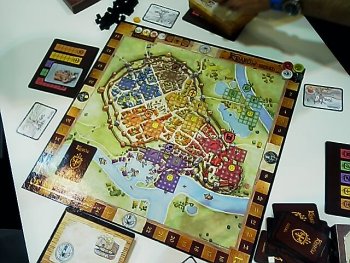 All four seasons of a year are played in the same fashion, and so the teams slowly will accumulate influence tokens in the different districts of the city. Likewise, the players will collect money in their treasure chests, and this money will be used during the year's end phase after the fourth season. During the year's end phase each player will secretly assign his money to each of the districts, and all players then will simultaneously reveal their allotment. The money is placed in the districts according to each player's choice, and then the number of influence tokens of a team within each district is added up with the money to determine whether one team got the majority within a district. Each team will score victory points for each district in which they got a majority of influence, and the victory points gained by each player will be marked on a track on the gameboard. However, it is not just the teams who will get influence points. As indicated, each succesful Intrigue card played during the current year was collected, and now all successful Intrigue cards will be sorted into the coloured groups of each faction. The different factions in the game have a marker on the victory points track as well, and now a victory point is recorded for each of a faction's successful Intrigues. After all evaluations were made all influence tokens and cards will be discarded and a new year will start with the distribution of the season cards. The tricky element in Krakow 1325 AD becomes visible when you remember that each player was assigned a hidden secret identity at the beginning of the game. Each of the hidden identity cards matches one of the four factions in Krakow and when the cards are revealed at the end of the game each player is allowed to add the current score of his faction to his own victory points. Thus, in the course of the game the players will be faced with the basic dilemma whether they want an Intrigue to succeed or not. It is not always advisable to assist a team partner, since each player also will have a look at the current Intrigue card to see whether it is a card matching the player's secret identity. So, sometimes it may be paying off to allow an Intrigue card of the opposing team to win, so that in the end the player's faction may profit from this card as well. This central mechanism of the game is fuelled even more by some special modificators which will be applied at the end of a year. So the faction with most successful Intrigues during the year will get a bonus whereas the opposing faction will get minus points. This represents the fact that the Citizens and the Underworld hat each other as much as the Clergy hates the Secret Societies. Also, further spice is added by special Intrigue cards which allow their player to apply a special action and special blocking cards. The use of such cards will be rewarded with additional influence points as well. 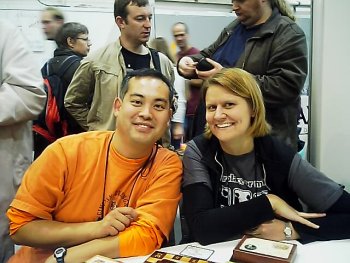 Despite a somewhat one-sided start which saw Valerie and me who had teamed up against Dale and Peter take a good lead, the game seems to fall into balance after a number of rounds and players will get a grip of the game's basic mechanics rather quickly. It takes only a short time to get used to the implications the outcome of a turn might have on a player's general standing, and when this lesson is learned the real playing fun will develop. Members of each team constantly will be either delighted or angered by their fellow's actions, but since each player keeps his hand of cards secret there never is real certainty whether a player had the required card to chance the outcome of an Intrigue. This makes it difficult to guess a player's secret identity, and it certainly helps to keep the interesting atmosphere of competition and constant mistrust. There can only be one winner, not a team!!! I took the time to feature Krakow 1325 AD with much detail because I think that the game is a perfect example of the high production quality which self-publishers reach these days. The game is fondly illustrated and it offers an entertaining gameplay, and it just shows the great variety of quality games a visitor of the SPIEL can chose from. Finally, the game also shows some of the advantages of going as a self-publisher, and most outstanding amongst these is that Krakow 1325 AD could be published despite the fixed participation of four players. Most major publishers would see such a number of participants to be not marketable, but a well-planned and devotedly designed self-publication may turn out to give a chance even to a game with a fixed number of players. Before I wanted to do the final testing session today, I met once again with Ralf and were talked about our experiences today. He has tested a number of interesting games as well, and here are some of his experiences: "Hi, folks. So here I am with my first live report from the convention in Essen. After missing the convention last year due to an unexpected trip to China, I am now back in my native town to visit this big event once again. As Frank already told you, I help writing daily reports this year to give you an even deeper impression of the atmosphere and a wider overview over the new games." "After arriving at the ticket office I was quite happy that I had bought a ticket for all days in advance and had not to queue up at what seemed to be a queue for 20 minutes and longer. Hoping to be one of the first in the halls I was quite surprised that a lot of other people were there before me and the best places were already seated. Well, that´s life and so I had to go the hard way. But all in all the day was not too crowded and you had much more room than a few years ago, when the convention took place during the holidays." 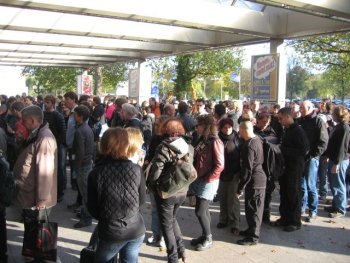 "The first booth that came into my focus was Kosmos and of course there was no chance to get a free stool. Der Hexer von Salem aroused my interest and I bought a copy with an autograph from Wolfgang Hohlbein later that day, but I was not able to do a test so far. I am hoping that I can give you more details some other day. Kosmos had some other games that adopt themes of novel or movies. In any event this seems to be a favorite background for many publishers this year, hopefully the game mechanism can live up to the big expectations the titles promise." "At Ravensburger I was luckier. Together with four comrades I managed to find a table and get a copy of Der Name der Rose. The board shows several buildings of Apinin, the city were William of Baskerville and Adson try to find the murder. All players draw one card at the beginning of the game that show which monk they are. This must be held secret until the end of the game. Six monks are suspected and can be moved from building to building by the players. To do so, the player plays one of his cards, showing a building where he can draw any monk. Another possibility is to play a card showing a specific monk who can then be placed on any building. Monks, who were moved, increase or decrease their suspect points depending on different points on the buildings. William and Adson can be moved, too, giving more possibilities to change the suspects of the monks. It is wise not only to favor his own monk, otherwise the other players will identify the monk and then it will be very hard to win the game. Each card moves the clock and when a day is over a scoring take place. Then the suspects are turned into evidence. The monk with the highest suspect gets five points of evidence, the next four and so on. After the scoring, the suspect is set up to the origin and another day takes place. In the end all players tip the monk of all other players. All right tips bring the monk more evidence. The player with the least evidence wins the game. Although the game mechanism is very interesting, me and my comrades were not fully confident. It is very hard to hold your monk secret, once you are in the lead of evidence. Luck plays a major part in the beginning. In our round all players concentrated in giving suspect to two monks at the beginning, and these monks had no real chance in the rest of the game. But maybe some more rounds will give you more confident in hiding your monk. Anyhow more had to be explored…" 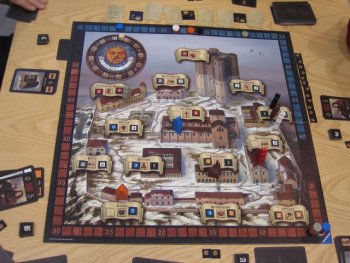 "Pegasus has brought the German version of Pandemic (Pandemie in German). All players try to control four different diseases in the world together. So there is no single winner, it is only the game or the players. The board shows the world with a lot of cities that are connected by road and ship lines. In a turn the players move along the cities and try to heal fulminating diseases. After the action phase, when the moving and the healing takes place, the player draws two new cards that show a city in the world and has one of the four colors of the diseases. With these cards the player can fly (to the city on the card). Five cards of the same color can be used to find an antidote against this disease. At the end of a turn a player draws two city cards, showing the places where a new disease breaks out. This is indicated with a stone on the city. The fourth stone in one city leads to an epidemic, infecting all other cities in the neighborhood. The game is won if all diseases are defeated. There are many more ways to lose the game. The game was great fun. It is not too complicated but gives enough possibilities to act. Due to the epidemics the game can change very rapidly. In our round we seemed to be very good and were close to win the game, when some terrible epidemics broke out and we finally lost the game. Each player takes one profession giving him some special abilities. This works very well and the player really have to support themselves to win the game." 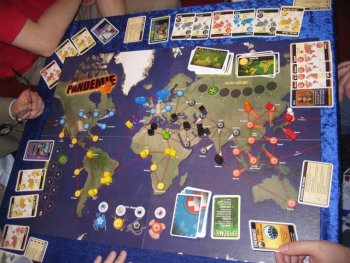 "Queen Games has come with a very strong Chicago Express. The players bid for shares of four (five in the end game) different railroad companies. In the turn the player can build the railroads of the different companies. The longer the railroad and the more interesting the connected cities the more valuable the share becomes. In his turn a player can choose between placing a bid for a new share, expanding a railroad and building a house which makes the railroad even more valuable. There are a limited number of these possibilities in a turn, which is indicated on the edge of the board. When there is only one possibility left at the beginning of a player, the turn ends and the companies distribute dividends. The game is tactical and the game mechanism works very well. In comes in the typical Queen Games design it surely is one of the strongest games of this publisher in the last years." 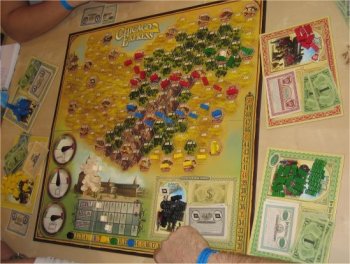 "That's it for me today. I am out. I wish you a very nice night. Sleep well and see you tomorrow." Okay this were Ralf's experiences for today, but I have one rather interesting testing round left for today, and so let me take you onto an incredible trip into space… Two years ago the Czech publisher CGE made a great appearance at Essen with their rather popular civilization-game Through the Ages which was awarded the International Gamers Awards in 2007. Last year's Galaxy Trucker was quickly becoming popular too, and so it is no wonder that they have come back this year with Galaxy Trucker - the BIG Expansion which offers new rules and enhancements for the game. However, the focus of my interest today is the game Space Alert, a science fiction boardgame which tries to make a useful symbiosis between cards, a gameboard and audio-technology via a CD-player. Over the years, there have been several tries to implement games with electronic assistance, but games like Dark Tower from MB or King Arthur from Ravensburger were rather easy to beat due to their limited playing depth. Knowing the games from CGE I was certain that the author Vlaada Chvatil would have done all he could to prevent a more or less predictable game, and I must say that I was not disappointed. 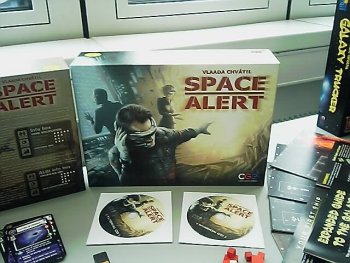 Upon approaching the CGE booth I could already hear the commands coming from the audio CD, instructing the players to draw new cards, finish their card placement for upcoming rounds or to reveal new external or internal threats for their Spaceship. Taking seat for a demo game, myself and a crew of other inexperienced Space Academy cadets were sent onto the mission of our life, the scouting of a new space quardrant. For this mission we were given an extremely reliable spaceship of the "Sitting Duck"-class and we were given a set of action cards, and after receiving some instructions who to play we were hurled into space. The game actually is divided into two parts, the planning phase in which the threats are revealed and the players plot their moves for the 12 rounds of the game, and the re-play phase in which the players actions are revealed and played through. During the planning phase the CD player (or mission cards if no player is at hand) takes the role of the ship's computer which instructs the players when to place cards, when threats are revealed (drawn from certain decks of cards) or when bad things happen like an interruption of communications which prevents the players to talk with each other. It will now be the task of the players to plan their actions for the whole game, reacting with their characters by moving them through the spaceship and using and repairing certain weapons and machinery. For this reason the players have a number of action cards which they can put in numbered slots for each turn of the game. These cards give them either the possibility to move their characters or to use/repair weapons or machinery at their character's current position. To visualize everything, a big gameboard with the six sections of the ship is placed between the players, and all their character figures are places into the central (bridge) section of the upper deck. Whenever new threats are revealed, reminding markers are placed within the spaceship or at external ranged flight paths, and the players will have to calculate the actions of these threats by checking the options on the threat cards. 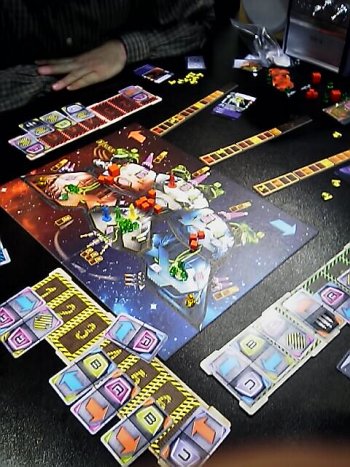 When the CD-track ends all threats will be revealed and the players (hopefully!) will have placed action cards for every round of play. The planning phase instantly ends, and in the upcoming re-play phase the players now will step-by-step reveal their planned actions following a mechanism which is a bit alike to Roborally but much more advanced. So, players will move around the ship's decks, power up weapons and shields by transferring energy, firing all sorts of different weapon, command troops of Battlebots, fly a fighter squadron and use different kinds of special appliances. All this is done to keep harm from their spaceship, but if a threat survives a round of player actions it will now have a chance to move closer and fire its weapons or do other kinds of mischief. The kind of action which will be chosen by the threat all is pre-scribed on the card of the threat. Different scales will be adjusted after each round, showing the current status of the spaceship and of all threats. Step-by-step, the Spaceship will start to fall apart due to damage caused by the threats, and this maelstrom will be fastened if the players failed to cooperate during the planning phase. Destroyed or malfunctioning equipment will render player actions useless, and thus the essential order of the actions chosen by each player will be placed at hazard. The game will come to its end either if the players' spaceship is destroyed (meaning an instantly lost game) or after the 12th round. At that time the scanning modules of the ship will have scanned the new sector and the hyperjump will take the ship home, removing it from any further danger. Now the players add up the victory points for survived or defeated threats and deduct penalties for damage and unconscious crew members. The final score then may be added to the Ship's Log. WOW! I have rarely played a game which is as fast paced as Space Alert, and the game offers an absolutely authentic and capturing playing atmosphere. While it is true that this game is no boardgame in the traditional meaning, I rank Space Alert very high in the area of interactive entertainment games, a class of games which is splendidly represented by Ca$h'n Gun$ and other kinds of "party"-games. To my absolute delight Vlaada Chvatil was able to avoid all dangers which are usually associated with the use of technological gadgets in games, and even the fact that the soundtracks on the CD cannot be altered is no hindrance since there are several soundtracks available and the threats of each mission vary through the composition of the different decks of cards. This ensures a high-replay value, and to my mind it gives high attractiveness to the included campaign-rules which put the players to the task to play (and survive) several missions in a row with only limited possibilities for repair between the missions. It was easier for a newcomer like me to get used to the rules by having them explained to me here at the show, but the gamebox actually contains a very concise tutorial procedure which takes you step-by-step into the game and the full rules. A nice passport to a great trip into the Unknown! Sleep? Unknown so far but desperately needed now! See you tomorrow!!! Friday, 24th of OctoberHello everybody! Are you ready for another day's stroll through the halls of the SPIEL?  After yesterday's excursion to some publishers from Eastern Europe, I though that today would be a good day to have a closer look at some of the game brought to Essen by publishers from Western Europe. Thus, I decided to start the game with a visit to the booth of the Lamont brothers in order to have a day's warm-up with a dogsled in the cold regions of Alaska. Alas, this year FRAGOR GAMES had to refrain from using their usual resin-figures which have made their last games so popular. However, the board pieces were looking quite beautifully, and after the rather unusal game Antler Island last year I was nonetheless very eager to have a go at the Lamonts' new racing game. 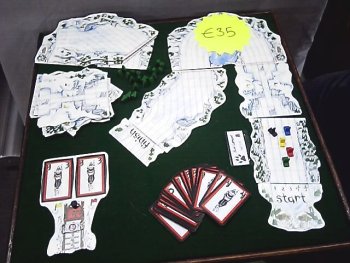 Before the game may start, the players will have to use a number of track pieces to build up a racing track. Naturally, there exists a Start and a Finish, and between them comes a chain of straight pieces, bends, U-turns and even some chicanes like a Canyon or a growing of young trees. When the track is ready, each player is given a sled playboard on which two dog-cards and a brake-marker can be placed. Also, each player choses a starting place and places a wooden playing piece there. Finally, each player is dealt a hand of five dog-cards and the race may start. Basically, a player may chose to play either one, two or three of his dog cards in his turn. Two dog cards can be placed on the two dog spaces in front of the sled, whereas another card can be discarded to fix the current brake rating. Once a player has played his cards, he may move his sled forward for the sum of the two dog cards, substracting the current brake rating. However, a straight move only happens when two identical dog cards have been placed in front of the sled, but two different dogs card will result in a sideward movement of the sled which is called a "drift". For each point of difference between the speed of the two dogs the sled will be pulled one step into the direction of the slower dog, because the faster doge pushes the sled to that side. This results in a drift which means a change of lanes, and in essence the sled's direction is controlled by this mechanism. Thus, a player who wants to get past his opponents or to turn the sled in a bend will need to keep his dogs at different speed in order to master the manoeuvre. If both dogs run at the same speed the sled is fully balanced, and this results in a bonus movement allowance which will push the sled forward faster. However, there is a danger of going too fast in so far as there exist speed limits at the entry of the bends, and whenever a sled enters the bend above the speed limit the player has to take a Damage card. 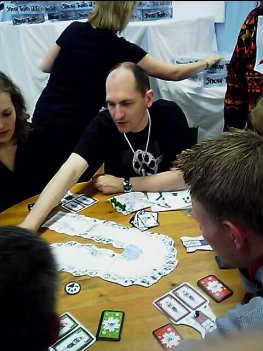 Damage cards are also taken if the Sled is forced to leave the racetrack (by a wrong drift or a narrow bend) or if one sled rams another sled. These damage cards do not slow the sled down, but instead the player has to keep the damage card at his hand, reducing his maximum hand cards by one. The more damage cards a player takes the less dog cards he may hold, and if a player collects his fifth damage card he may no longer hold any dog cards and is out of the race. As indicated, special chicanes bring a bit more spice into the game, and here the track either will narrow down to a single lane or run through some tree saplings which the players must avoid. Each tree rammed along the race once again results in the taking of a damage card, but the following players will be quite happy because the tree will be removed after the collision. The roots of Snow Tails seem to go back to a mixture between Mississippi Queen and Um Reifenbreite, but the Lamonts nevertheless succeeded in giving Snow Tails its own special attractiveness. The basic principles of the game are learned rather quick, and even players which might have some difficulties with the drift-movement rules will find some assistance because the sled playboards of the players have a mechanism for turning them on the spot so that the correct positioning of the cards can be simulated. Due to its low complexity Snow Tails is an ideal family game with a good racing spirit, and the varied track should leave ample opportunities for the players to create their own season's dogsled racing league. Coupled with nice graphics and a high replay value, I think the Lamont brothers once again positioned themselves well amongst the interesting games of this year's convention. As a final bit of information I might also pass on that I asked Gordon about the 50-copies limited edition of Royal Leapfrog which had been available for pre-order for a rather short time. Due to the fact that the game had sold out via the Internet in a matter of hours Gordon indicated that the game might find a reprint at some time in the future, and so we might keep our fingers crossed that this beautiful edition might get available to a larger audience  Virtually staying in the Wild Lands, I went into a more moderate climate zone which seemed to be haunted by bands of outlaws, and thus there seemed to be some sense in the old German folk song Im Wald da sind die Räuber. And indeed, the new game by KRIMSUS KRIMSKRAMS KISTE (finally back with a new game, and at the same time the first boardgame they have ever done) puts the players into the positions of bandit chiefs who are raiding Homesteads, Inns and Castles from their encampments hidden in the woods. 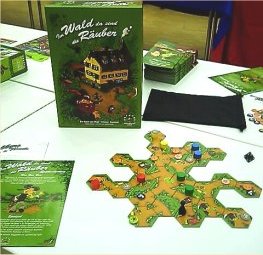 The gameboard used is meda up by hexagonal tiles, and at the beginning a center road crossing of three tiles is placed at the gameboard. 12 additional tiles will be placed by the players around this crossing to form the playing area to start the game, but the remaining tiles will be shuffled and placed down as three hidden stacks which each consist of 12 tiles. While setting the game up, each of the players also receives a tile which features his encampment, and these tiles will be added by the players so that they are present with the startup gameboard. Certain rules must be observed when the tiles are placed, so that roads always must be placed in a way that they connect to the gridwork of roads available on the board. This actually prevents the creation of a wholly independent area. Furthermore, a load of 40 treasure counters (gems, coins, gold bars, jewellery and silver cutlery) have been placed in a bag, and a treasure counter can be drawn and placed on a new tile if a new Homestead is revealed, whereas it must be placed in case a new Inn is placed. Castles have more riches than the aforementioned buildings, and so two treasure counters must be placed on a newly found castle. Once the intial placement phase is finished, the real game may begin. A player begins his turn by drawing and lacing a new tile from the first of the three face down stacks, and when a building should be revealed on the new tile treasure tokens may be placed just like it was done when the game was set up. Next, and more important, comes the movement phase in which the active player actually may start to move with his outlaws from his encampment, and each of the outlaws has its own movement allowance to be moved a number of steps from one tile to another. Whenever a space with a treasure counter is reached an additional movement point may be spent to take up the treasure, and if the player succeeds in carrying back the treasure to his encampment he may place it in front of himself. A limited number of special draught tokens may be used by each player, and these markers may be used to double the movement allowance of one of their outlaws. Also, special rogue counters may be discarded to force another player to lose a treasure counter he was carrying, and this counter then is placed on a neighbouring space where another player possibly may steal it with one of his outlaws and carry it home. An evaluation will be done whenever one of the three hidden stacks of tiles has been used up (marking the end of a third of the game), and in this evaluation the players will receive victory points for their treasure counters. However, the value of the treasure counters increases when a player possesses more treasure counters of the same kind, so that the player's basic strategy will be to acquire the right treasure counters to get most victory points. To spice the game up and to give the players a challenge while carrying the treasures home, a guardsman is patrolling the forest and rides from one Homestead to another. He comes into play when the first Homestead is placed during a normal turn, and the player who activates him also has to mark a Homestead to which the guardsman will ride. From that moment on each player will have to roll a dice and move the guardsman for the rolled number of spaces on the shortest possible way to the target Homestead, and the player who is active when the guardsman reaches the Homestead will be allowed to identify yet another Homestead to which the guardsman will ride. This movement is continued till the end of the game, and whenever the guardsman comes upon an outlaw that outlaw is placed back in its player's encampment, possibly discarding a dropped treasure on the space where the guardsman was met. A person which actually met the Robbers in the old folk song was a Maiden who was on her way in search of a blueberry bush, and a token depicting the Maiden will be placed on the first empty tile which is placed during normal gameplay. The Maiden-chip may be taken just like a treasure counter, and if the player takes her to the blueberries on the central crossroads he will receive a reward of three victory points. The Maiden then is removed from the board, but it is placed again once the next empty tile has been revealed. Finally, even outlaws like to celebrate a good day's work, and nothing would be better than doing this in an Inn with lots of beer. Thus, the players may try to get their outlaws into Inns before the third and final scoring, and each outlaw at an Inn at the final scoring will bring additional victory points. Whereas some of the games I have seen yesterday can be qualified as being specialist games for hobbyists, Im Wald da sind die Räuber just like Snow Tails in the best possible sense falls into the category of family boardgames. The playing mechanism offered here actually assembles some features which can be found in different other boardgames, but the whole composition of these elements is used in a new, unique and entertaining way. Personally, I rather like such "tease your fellow players" games, and through the movement of the guardsman and the rogue chips some valuable victory points may be lost at a crucial moment. Taken together with the setup phase and the constant placing of new tiles the game even offers some strategic impact, and so I think that Mark "Krimsu" Sienholz and his crew actually have succeeded quite well in bringing a bit of the long-lost German folksong to life in their cute new boardgame. 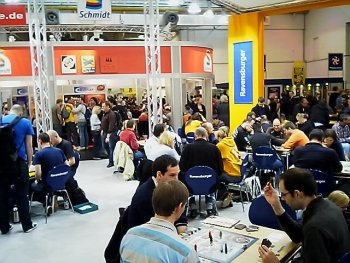 The meeting I would like to talk about next is somewhat special, but it is nonetheless another great story about a gamer's passion which I would like to tell at this place. So, at an arranged time this morning I went to the restaurant of the convention area, and there I met the two Irishmen Brian Brennan and his son-in-law John Costigan. Brian Brennan, 80 years old and a former architect, had created a cardgame about the auctioning of property in the last few years which he had tested quite often with his friends and family, and a time had come when he actually begun to think how to make the game available to other players. Knowing nothing about the world of games, Brian's daughter Una actually had searched the web for some informations, and some months ago she actually stumbled upon my website and decided to contact me on the phone. We had some very interesting talks about the games-market at large and how good games could be identified, and I had told Una quite a bit of our unique convention here at Essen which is the world's larget tradeshow in the area of board- and cardgames. When this year's SPIEL was drawing near, I got another mail from Una, and she told me that her dad and her brother-in-law actually would be coming to Germany to visit the SPIEL, and they had arrived yesterday and had taken in the atmosphere of the show. Collecting some information handouts from the Merz-Verlag in order to get an impression how a booth possibly could be ordered for next year's SPIEL and talking to a publisher I could recommend, Brian and John had spend yesterday's afternoon to get some first impressions, but today we had agreed to meet in person so that they could show me the prototype of the game and collect my opinions on the game's mechanics. We had a rather long talk about the matter how the game could be positioned, and the prototype which runs under the trademarked name of "Prop Auction" actually offers the potential of becoming a quite entertaining, low complexity game with a short playing duration of about 30 minutes. The real question proved to be how the game could be marketed, since a major publisher had told Brian quite frankly that the topic somewhat does not seem fit for a major family audience because of its somewhat economic topic, and I partly share this view considering the German market. Due to some specifics of the game it might be received differently in some other countries, but in the end we agreed that the finding of a publisher would be somewhat of a problem. However, Brian was not disheartened by this, and instead we talked about risks and possibilities to dare the venture of hiring a booth for next year's SPIEL. Being no marketing expert, I still felt that the game might have some chance in a limited first printing, and thus Brian and John now will be weighting the possible financial involvement against the undeniable fun of being present here at Essen with a self-created game. It has been a great pleasure to meet these two gentlemen, and I feel that it might be possible that you could meet them again during my Essen reports next year at a slightly different position.  However, while I was having the meeting with Brian and John the convention-day was wearing on, and directly after the meeting I went up to the big reception hall where the Awards ceremony for the International Gamer's Awards was scheduled to be held this year. So, let's how G@mebox co-author Ralf Togler has spent the day… "Hello again. Today I came with my wife and naturally we looked more for games and books for my 2 ½ years old son than for us. But I also managed to do some tests of the more complex games and here are the results:" 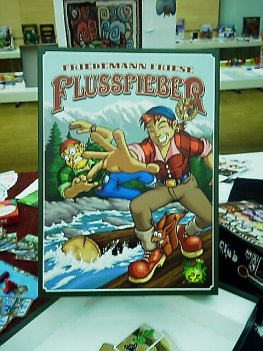 "Friedeman Friese of 2F newest game is FLUSSFIEBER. In the game the players try to bring their two tree fellers from one end of the river to the other. Next to the tree fellers of the other players there are also a lot of woods in the river and so soon a traffic jam happens. One by one the players play a card that shows how many field on the river the tree fellers may move. A feller may move up to two other players or woods one step further but unfortunately there is no way to move three or more of these barricades. So the players try to block the other players especially where the river becomes narrow and only one or two fellers can pass at once." 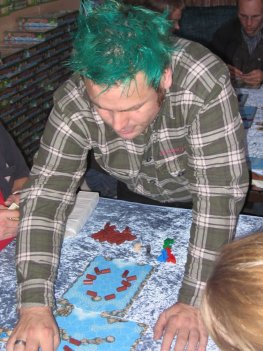 "While this alone may look easy, the rapids on some river fields make the game much more complex than it looks like. Once a feller is moved on one of the rapids, he can very soon be one of the last ones again. The game is quite typical for 2F. It is easy to explain, easy to play but not too easy to win. It needs a lot of tactical understandings of the game to move his fellers quick through the river. Especially in the narrower parts of the river it will take some time to do a clever turn, especially if this part is combined with rapids. The game comes with different parts of the river, so several degrees of difficulty can be played." 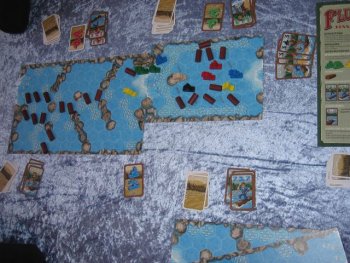 "After that test I accompanied Frank to the ceremony for the International Gamers Awards. The game which had won in the multiplayer category is AGRICOLA by Uwe Rosenberg, and the two player category was won by 1960 THE MAKING OF THE PRESIDENT by Christian Leonhard and Jason Matthews. Uwe Rosenberg had published AGRICOLA under his own label of LOOKOUT GAMES, whereas the English versions of both games actually were done by Zev Shlasinger's Z-MAN GAMES. In the absence of Greg Schloesser the ceremony was conducted by Alan How, so we actually missed Greg's yearly expedition into German. Unfortunately the room where the award was given was rather big and a bit tucked away, so the number of visitors which found their way up there was quite reduced in comparison to previous years. This on the other hand allowed me to sit in the first row and gave me more room to do some quick shots with my camera."    "My wife and I went to the smaller publishers thereafter and we found the game EL PELEGRINO where you can walk a part of the famous Jacobs way, a famous Pilgrim way in Europa to Santioga de Compastello in Spain. Some years ago, the German comedian Harpe Kerkeling walked this way and wrote a very famous book about his journey. This woke my interest but when I had a closer look I realized that the game is a simple game of dice combined with some questions about the Pilgrim way with some background information, too. For fans of the book and the way it should be okay, but for people who really want to play the game mechanism is a little bit too weak." 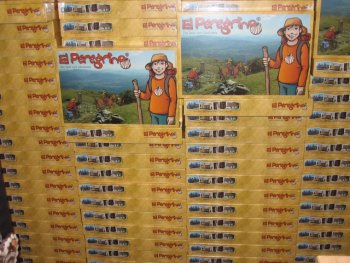 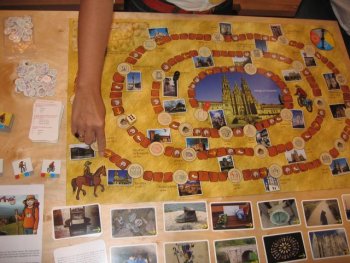 "DOMINION of HANS IM GLÜCK offers much more game mechanisms. Adopting some ideas of traditional trading card games like Magic, the gathering, the game concentrates on building a powerful deck of cards. At the beginning the players only get some money on their hand. All in all the players get ten cards from which each player takes his first five cards in his hand. In his turn the player can buy one new card, either more money or a building card, that gives him more abilities in the later turns. All cards, the money cards he spent, the new bought card and all cards left on the hand, go to the player´s own discard pile and he takes the next five cards for the next turn. If there are no more cards left, he shuffles his desk from the discard pile and takes the rest of the cards from this new stack. So the players play with an increasing desk and like in Magic they always take the discarded cards back on the hand. In the later rounds there is also an action phase before the buying phase in which the players can play action cards (normally buildings) that give them more abilities in their turn. It is now very important to choose the right new cards in the action and the buying phase that can be combined in the later phases. So for an example a special building can bring you one more action, one additional buying phase and two more gold in your turn. In the additional action phase you could place another building that allows you to buy a building for four gold, with the additional buying phase you could buy more gold or buildings and you would have more money to spent, too. Some buildings allow you to exchange some cards from your hand and others will do harm to your opponents, too. The game box comes with a lot of different buildings, so that you can increase complexity gradually. I tried the starter desk and had a lot of fun at the beginning. But soon I wished to have more possibilities to harm my opponents. I guess there are more complex cards you can bring into the game, but I did not have the chance to do another round again. At HANS IM GLÜCK they said that the players either like the game or hate it. I must confess that my high expectations were not fully fulfilled so far. But the game offers a lot more buildings I could not try and so I think that it is only a matter of time until I become a fan of the game, too." 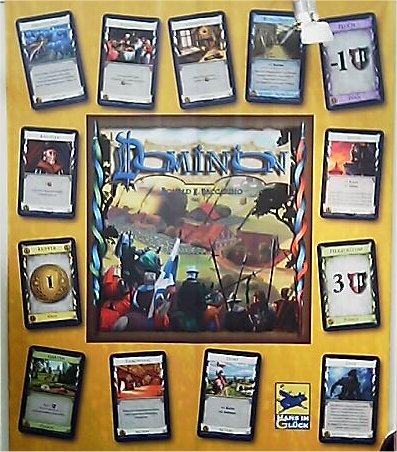 "Finally we tried DER HEER DER ZIEGEN from AMIGO. The game is a further development from Günter Burkhardt. The original game with the name KUPFERKESSEL CO. was published in 2001 from Goldsieber. Once it was a two player game, now it can be played with 2-5 players. The game mechanism basically remains the same. The players move around a 7x7 card grid, play cards that show their number of moves and place these cards before them. In the column or row their figure stops they must take a new card for the hand. The players must collect cards of the same art (goat) to score. Once he has collected cards with a value of eight he may place small goats on every card of the same art on the table. These cards are blocked for other players from now on. In the end game cards with goats on it can be arranged with the help of dog cards, because goats nearer to a player´s headquarter have a higher score in the end. As I already liked KUPFERKESSEL a lot, I also think that DER HERR DER ZIEGEN is a really good game. KUPFERKESSEL was more difficult, because you had to remember the cards of your stockpile. In DER HERR DER ZIEGEN on the other hand, cards are placed visible for all players which makes the game a little bit easier in my opinion, your children will thank it." 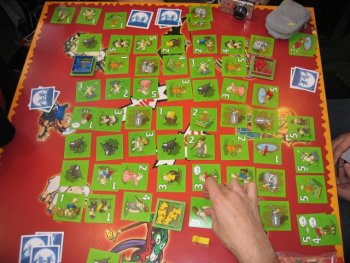 "So that´s it for me today, see you the next day again." However, Ralf was not the only one to be free for the afternoon, and thus I first chose to pay a visit to the booth of LOOKOUT GAMES where a friend had asked me to get him some special items for Agricola. As indicated yesterday, the SPIEL is producing its own hypes, and one of these actually are the regular queues at the LOOKOUT booth. 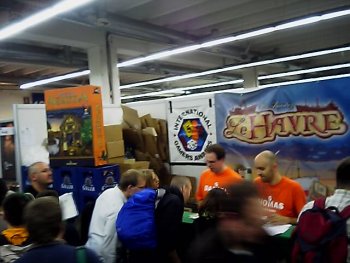 Quite a few additional goodies for Agricola are available here at the convention, and amongst these rank a special X-deck of cards (featuring Space Invaders !!!) which can be also found in the current issue of the SPIELBOX, wooden playing pieces of sheaves and pumpkins to replace the yellow and orange disks, a mini-expansion featuring "Four Seasons" together with the needed rules on a postcard and even a special bottle of Agri-Cola which will be sold to assist a charitable project in Africa with the money. Also, Hanno Girke had told at the Awards Ceremony that their new game Le Havre was selling quite well, and they were expecting it to be sold out tomorrow. 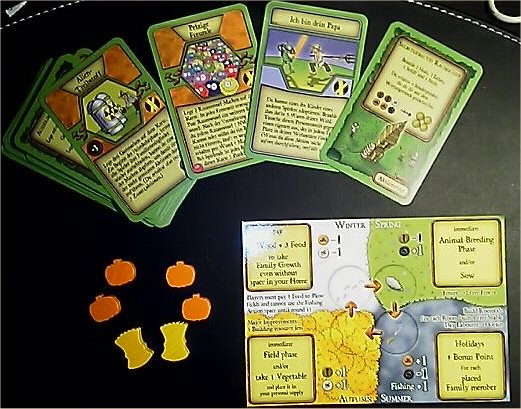 A company which had done a great first game two years ago was HURRICAN GAMES with the mystery game Mr. Jack, and so the HURRICAN booth was another place I needed to visit today. The topic of this year's game is much lighter, since Hurry Cup actually takes the players to a race along the curved roads along the Cote d' Azure back in the 1920's. 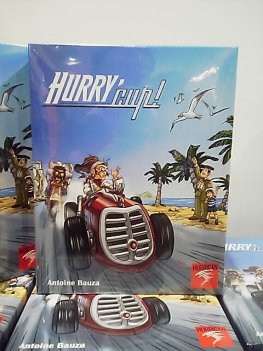 The game uses dice to determine the movement allowance of each player, but despite the fact that all dice (which are rolled together in a dicing cup) are of different colours no player actually is assigned a fixed colour. Hurry Cup is a game which needs fast reactions, since large playing figures matching the colours of the dice are placed at the middle of the gameboard, and once the dicing cup has been lifted the players need to look at the dice to decide which dice they want to take. Showing a fast reaction, the players then need to grab for the coloured playing figures, and the player who gets a figure also will be entitled to use the dice of the matching colour. Several factors have an influence on the outcome of the race, and most important here are the speed limits which are applied in the bends of the road. The players may move their playing pieces forwards up to the number of spaces indicated on their coloured dice, but in addition they will roll another dice and add the results of both dice together. Multiplied by 10 this gives the current speed of the player's car, and if he should be going faster than the current speed limit he will be forced to end his move before the speed limit applies. Likewise, the players can influence their movement by the use of special tokens which allow them to take shortcuts or to ignore a speed limit. Some of these tokens are available to each player right from the beginning, whereas others may be collected on special spaces along the racetrack. Some fun in this context is created by the signal-horn, since the player who uses it has to shout "honk-honk" and then is allowed to chose a dice from the cup before the results are revealed to the other players. Any attempt of strategy in this game is squashed by the need for reflexes, and playtesting it with a group of three strangers I was severely beaten. With a group of good friends Hurry Cup might be proven to be a good beer-and-prezels game, but as you can see it has none of the playing depth which Mr. jack could offer. 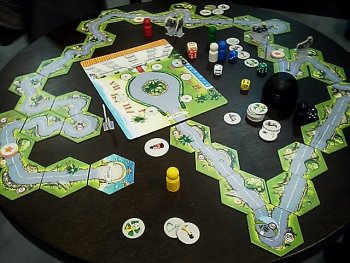 Another game which I wanted to present during the show actually has found the favour of one more of my G@mebox co-authors, and so I went to the booth of JKLM / LUDORUM to have a look at ICE FLOW by Dean Conrad and John Streets. The game had won the Best New Board Game Awards at the UK Games Expo 2008, and Doug Adams from Australia recommend the game to be rather worthwhile to look at. Have a look at what he has to say about is… "I first heard of this game while surfing Boardgamegeek. I began reading about it, and the more I read, the more intrigued I became. I ordered it direct from LUDORUM, and eight days later I had a copy in my hands." "ICE FLOW is a race game, inspired by the Karl Bushby Goliath expedition (walking from South America to Europe by foot). Players control three explorers, and are racing to be the first to get their team from Alaska to Siberia. Anyone familiar with geography will quickly realise there is a chunk of water in between called the Bering Strait. Players have to move their explorers across the Strait by a combination of swimming and hopping between ice floes." 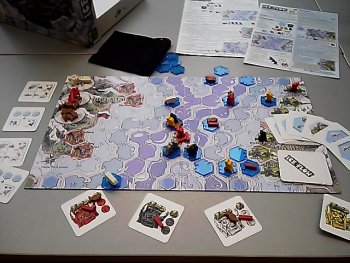 "ICE FLOW creates a positive first impression when you open the box. There are three full colour rulebooks included, in English, French and German. Also included are a colourful game board; custom made wooden pieces featuring polar bears, explorers, fish and rope; a small deck of cards; and the transparent plexi-glass ice floe pieces. When you play the game, you realise a lot of thought has gone into getting the components right, especially the floes, which are remarkable." "The game board is nicely done, illustrated in a cartoon style, yet retaining an attractive appearance. It features Siberia and Alaska, separated by the Bering Strait. A hex grid overlays the play area, regulating movement and stacking of explorers. The Strait is divided into channels, or lanes, which the ice floes move along at speeds between one and three hexes. The lane speeds are also colour coded so even if you can't see the speed indicators, you can tell at a glance how quickly the ice is moving along a particular channel." "On the Alaskan side there are six stations where the explorers depart from. There is an illustration of a rugged adventurer on each of these stations, with a determined look on his face. In the centre of the straits are the Diomede Islands - Little and Big. (Trivia time - the date line passes through here, so depending on which island you're on, it's either yesterday or tomorrow on the other one!). The destination side, Siberia, features four stations representing the finish line for the explorers. Each Siberian station depicts an explorer enjoying a warm foot bath!" "Players set up a game by taking turns to place out twelve ice floes on the board. A card is drawn for each floe to it with some equipment - rope and fish. Sometimes an unwelcome polar bear will turn up on a floe. Once placed, the players take turns placing their explorers in Alaska - no more than two explorers per station. The game is now ready to begin." "ICE FLOW is a combination of race game, resource management game, and puzzle game. Once players are familiar with the game, turns are very quick. During a turn each player must take an "Ice Action", and can optionally perform an "Explorer Action"." "An ice action consists of doing something with a floe tile on the board. A player can either move an ice floe one to three hexes down a channel, depending on the channel speed, and whether any other floes obstruct the movement. Alternatively, a player can rotate a floe, spinning it in the hex by one hexside. Finally, a player has the option to enter a new ice floe onto the board - drawing a floe card and loading it with equipment (and a possible bear) - and placing it at one of the eight entry hexes on the board. One of the three options must be taken every turn, and this gives the game a nice sense of a body of water in a constant state of flux." "An explorer action is optional and is limited to two choices. Either move an explorer, or catch fish. Catching fish is straightforward - you hand in a piece of rope and take two fish from the supply - end of action. Movement is more complex... a player on their turn can move one of their three explorers. Movement is free, unless it costs something! Explorers can move from hex to hex for nothing, as long as they have a nice path of ice floes in front of them. However, there are exceptions ... if an explorer moves across a "crinkly" edge of an ice floe tile, it costs one rope to climb the ice wall. If a player enters a floe tile containing a polar bear, they must toss the bear a fish. If a player wants to swim a water hex, it costs them a fish to sustain them. Rope and fish used during a turn must come from the player's backpack card in front of them." "If a player does move an explorer, they may take one item from the hex they end up in and store it in their backpack. The backpack is a card that sits in front of the player, and holds three items (fish or rope). The backpack is communal, that is, each of your three explorers shares the items inside it, regardless of proximity to each other. As the ice floes are usually stocked with stuff, picking up something at the end of movement is a common occurence. However, as the game progresses, resources get used up, and equipment becomes scarce. Players have to carefully watch their equipment - if you are trying to get your last guy to the finish line, with an empty backpack, you'll find it tough going." "Players reaching Diomede Island usually take a breather there. Given there are two cards in the ICE FLOW deck for Diomede Island, it's a good place to gain new equipment - mainly because it's the only hex in the Strait that can't move!" "ICE FLOW features a light layer of player interaction. The main one to watch out for is not setting up a highway for the player playing after you to milk. This means carefully looking at their backpack to see what they are capable of, and trying to manipulate the ice to benefit you more than them. Sweeping up equipment ahead of trailing players can be annoying for them. Another area of interaction is the locking of floe tiles - once you have an explorer on a tile, no one else can move or rotate it, unless they have an explorer present as well. As stacking on each hex of the board is two explorers, it's quite easy to lock down nicely positioned ice floe tiles. The big area of interaction, though, is moving the polar bears around..." "If you move onto a floe with a polar bear, you must toss it a fish. You then have two options - continue to move your explorer, or move the bear. One of you has to go. If you move the bear, you send it off on a straight line until it exits the board, or lands on another ice floe. Bears moving onto other occupied floes have to be dealt with, via either escaping the tile, or tossing it a fish to keep it moving. You have to be careful here though, because allowing opponents to exit the tile may actually help them - I've even seen a player land in Siberia courtesy of a roaming bear! Ideally though, a moving bear will cause opponents to be emergency evacuated back to Alaska (a.k.a start again!), or help advance one of your other explorers courtesy of a free move. " "A game of ICE FLOW ends when one player gets their third explorer into Siberia, claiming victory. Each explorer must end up on a different Siberian station, which forces players to cover a wide swath of the board. It's not as simple as setting up a nice path of floes, and running your three explorers quickly across. I've found two player games take around 20 to 30 minutes, which feels perfect. I've had a couple of four player games which have taken an hour, and this feels a little long for a game of this "weight"." "ICE FLOW is a good game, and one I'd recommend. It pushes a lot of my buttons - it is easy to teach, looks good, has clear rules, plays quickly, and has good appeal as both a gamer and family game. Downsides? Perhaps some will find it dry, and deep ponderers may bog the game down with careful thought. For me, ICE FLOW is a keeper." 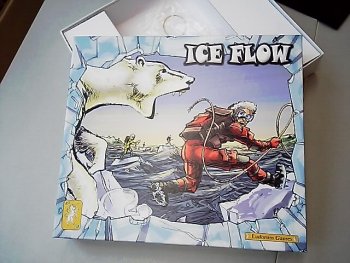 Getting the micro back from Australia, I made my way to the final test for today, and here I once again wanted to visit a publisher who had given me quite some expectations. Since their rather successful start with Ca$h'n Gun$ Cedrick Caumont and Thomas Provoost from REPOS PRODUCTION have invested their time not only in the creation of expansions and alterations for their first produced game, but as I had found out last year they also had been experimenting with a new game about a horde of Ghosts threatening a peaceful Chinese village. Now They are back with a game created by Antoine Bauza, and Ghost Stories actually takes the players directly into a setting which could have been found in the great movie "Chinese Ghost Story". A peaceful village has been erected over the grave of the fearful wizard Wu-Feng who had been slain centuries ago, but now the wizard finally has gathered enough power in the underworld to try to wreak his revenge on the world of the living. So, the players take up their positions as Taoist Monks, guardians of the village and the last hope against the incoming hordes of ghosts. In the middle of the table a village of nine different buildings is set up in three rows of three buildings, and the figures of the players' Taoists are placed at the center building. Each player then takes up his own gameboard and aligns it to the row of three buildings which faces his side of the table, additionally receiving Life point counters, a YinYang token and a Tao token of his colour. A deck of ghost cards is shuffled, and then a random incarnation of Wu-Feng is placed as the 10th card from the bottom of the deck without the players actually knowing which incarnation it is. 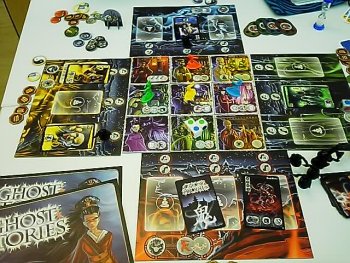 A player's turn in the game consist of two phases, the Yin phase in which the Ghosts in play will act and the Yang Phase in which the active player has the chance to react to the actual threat with his Taoist.t the beginning of the game there are no Ghost cards present in the three slots on each player's gameboard, but in case an empty slot exists the active player has to draw a new ghost card and place it on the correspongdingly coloured board. If the board corresponding to the colour of the ghost has no available slot the ghost will be placed on another board with an empty slot at the choice of the player.Thus, the first round of play will lead to the appearance of a ghost in each player's turn, and this will continue every time an empty slot is available on the active player's gameboard. However, letting all three slots get filled by ghosts is not of use either, since such an "overrun" situation will result in the active player loosing a Lifepoint. The actions of the ghosts are detrmined by a row of symbols on the bottom of their cards, and whereas some of them influence the rules of the game by putting restrictions on the players a special class called Haunter actually will cause a figure of a ghost being placed on the ghost's card. In following Yin phases this ghost figure will be moved forward one step per turn, and when it has moved two steps it has come to the border of the village. There it will cause the first open building in its way to be shut down (its cards is placed face down), and after this the ghost figure is placed back on the card to start yet another approach. In the Yang phase the active player may move his Taoist for one step within the village, and after the movement he has either the option to use the special function of the building he occupies or - if he stands on one of the eight outer buildings and is facing ghost card on the adjacent gameboard - to try to defeat the ghost. This is called an exorcism, and in order to defeat the ghost the player has to roll three Tao dice which will show either one of the four ghost colours or white as a joker colour. Each dice matching the colour of the ghost and the white jokers count as a hit against the ghost, and if the number of hits scored actually equals the ghost's resistance rating the ghost is defeated and removed from the game. If the result of the diceroll is not sufficient the players may add Tao tokens of the matching colour which he might have acquired during the game. Quite often the removal of a ghost actually will result in an additional effect, so that the players either may receive a benefit or the ghost will cause some final shockwave if mischieve before it goes dissipates. Typical benefits are the gaining of a Lifepoint or a Tao token, but the players also may get entitled to get back their YinYang token if they should have used it. This token can be used during a player's turn to consult one of the villagers without actually visiting his building, and so an additional benefit may be used during an otherwise normal turn. The village itself consists of a arrangement of nine typical buildings, and amongst these are a Buddhist Temple, a Herbalist Shop, a Cemetery and a Tea House. Each of the buildings has its own special functions, so that a visit to the Tea House will restore one Lifepoint whereas the Herbalist will give the player two Tao tokens. Quite interesting is the Buddhist Temple in which a player may acquire a small Buddha Statue which he may use to block one of the ghost spaces on the gameboards against the next ghost to appear, and in the Cemetry even the lifeless body of a killed Taoist may be brought back into the game. Each of the four Taoists actually possesses two special powers of his own, so that one of them can use special kinds of movement whereas the other can manipulate the dice. The third can perform two actions per turn, and the fourth actually has a special Mantra of Enfeeblement which may be casts to reduce a ghosts resistance to one. Whereas the presence of just a few ghosts still might seem tolerable for the players, there quickly comes a point when the players need to get rid of newly arriving ghosts quickly in order to avoid being overrun by them. Some of the ghosts have nasty powers, banning the use of Tao dice or tokens until the ghost is slain or even forcing the active player to make a roll on the Course dice which usually will cause some negative implications. The game comes to its cumulating point when the incarnation of Wu-Feng is revealed shortly before the deck of ghosts is used up, and now the evil wizard himself will join they fray with his considerable special powers. In addition to the fact that the incarnation is hard to slay because of a high resistance level, each incarnation possesses a different special power which will restrict the access of the players to some kind of benefit. The game is won if the players succeed in defeating We-Feng's incarnation and surviving the damage caused by his destruction, whereas the players loose if all of them are killed, if more than three buildings have been closed or if the stack of ghost cards is exhausted. However, to keep the players to the challenge the designers actually have included four different levels in the game, and where the Beginner's level only is supposed to be useful for teaching the game and learning it, the final "Hell" level is rumoured to be endorsed by Wu-Feng himself. The rising levels basically twist some of the conditions in the game so that the player's Lifepoints are reduced and the number of buildings which may be closed is reduced as well, and these minor changes are said to make the game much harder. In addition, some special rules are included so that the number of four players is not fixed but instead the number of participants in the game actually may vary from four to one. 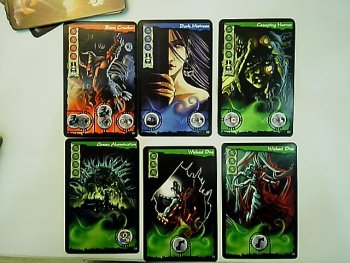 Once in a while my wife and I lean back to watch "Chinese Ghost Story" which is one of our favourite movies, and so I must confess that I am rather taken with this game. The artwork which has been used may look a bit dizzying when you see the game and cards all placed out for the first time, but a closer scrutiny reveals that it is absolutely beautiful with loads of details. This impressive playing atmosphere is taken up by the rules which - for my finding - reflect the background story of the valiant defence of a threatened village rather well. The players find themselves plotting and discussing their actions, and then hurrying from place to place to keep the outer borders of the village from being overrun by ghosts. Thinking of this breathtaking atmosphere, I guess that the game would suffer a bit of a slowdown if a playing group would try to plan their moves with highest perfection, and I guess that this kind of calculations would be somewhat against the spirit of the game. However, a normal bunch of players will love this group experience game, and just like Space Alert this new game by REPOS has left and impression of being a great cooperative game. Prize-Draw enhanced!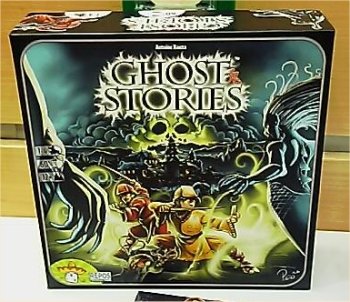 Thomas and Cedrick have sponsored a copy of Ghost Stories, and all you have to do to enter the prize-draw is to sign my SPIEL Guestbook ! 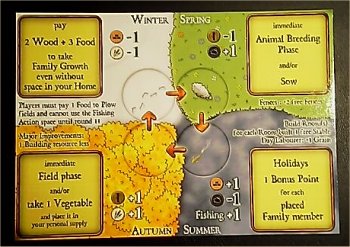 In addition, I got my hand on an English "Seasons" expansion for Agricola. This can also be won by signing my SPIEL Guestbook ! Well, that was my schedule for today. The games were lighter than yesterday, but nonetheless I hope that your curiosity for one game or the other might be raised. See you tomorrow!!! Saturday, 25th of OctoberHello everybody! Welcome back for some reports on a few quite challenging games which I have played today! 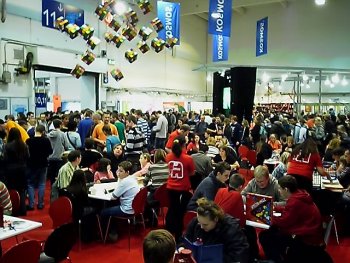 Seeing the game Comuni by TENKIGAMES rank quite high in the current standings of this year's FAIRPLAY convention visitors poll, I decided to begin my day by finding a space at the TENKIGAMES booth in order to playtest the game. 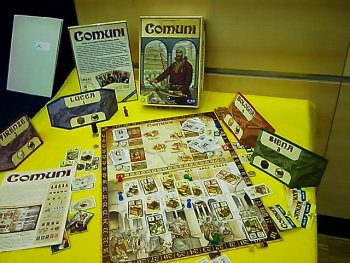 About a thousand years ago different city state (comuni) were competing for domination in Italy, and in this game the players have taken the roles of heads of mighty families who are responsible for the development of one of these city states. During the game it will be the players' task to increase their income (and victory points) by constructing four different kinds of buildings (Economy Military, Culture and Religion), but at the same time they must be heedful of the threatening external invasions which will happen at four times during the game. Each of the building types is assigned a special kind of resources, so that an Economy building will produce gold, Military allows armies, Culture increases craftsmen and Religion brings pilgrims. At the beginning of the game each player will receive a certain amount of each of this resources, the exact number of each resource ranging between one and three and depending on which city state a player was assigned at the beginning of the game. The gameboard mainly serves as a display for available building cards, but it also offers tracks for victory points and still available buildings cards. As a preparation the building cards will be divided into four decks ranking from A to D, and each deck will be shuffled and placed on a corresponding position. The decks will be exhausted in a rising order, with the cards being placed in the auction area where the players may try to acquire them, and whenever one of the decks is exhausted an Invasion takes places before the game is continued with the next deck. During his turn a player first has to think about his current building projects, and to get new building cards to his hand he will usually put one of his playing pieces and some gold at the head of one of the rows of building cards at the auction area. If an other player's figure was standing there, the newcomer has to bid more gold so that figure and gold of the firstcome player will go back to that player's stockpile, unless the player actually plays a pilgrim which would allow him to reposition his expelled figure on another row in the auction area. This kind of repositioning actually may cause another, weaker bidder to be dispelled or repositioned. A player who has a figure at an auction row at the beginning of his turn may actually claim the building cards available there instead of placing another figure, and all the building cards from the row actually go to the player's stockpile before the row is refilled with fresh cards from the currently active deck. A third choice would be to get some income from all buildings which a player already has constructed, but at the beginning no buildings are standing so no income is available. In the following phase the active player is allowed to build one of the building cards from his hand for free, but as an option he could also use a craftsman for each additional building he wants to build. As said above, four different kinds of buildings can be erected, but a fifth type of building cards actually exists and this type serves as a joker and can be used in any building. Buildings cards of the same type of building actually can be stapled on already placed cards so that higher level buildings slowly are constructed, and this higher levels are important since a player may generate a corresponding income equalling the highest level building in each category. The highest level which can be reached with a building is four, and several restrictions need to be observed when construction a building. Most important here is the fact that the building cards have a level so that higher level cards must be placed on lower levels, and so a card of the same category as an existing building does not automatically it onto that building because the level of the new card might be too low. Here craftsmen help again, since they may be discarded to temporarily increase the level of the new card by one level per craftsman. Alternatively, building cards may also be faced down in front of a player, and these cards effectively will be used as city walls. City walls are useful because they can be manned with an Army in case an Invasion, and they are needed to defend the town against plunder markers (penalities!). If a new building is erected or a level is added to an existing building the player also may turn his income-card of the corresponding category face up, and only if this card is face up the player actually is entitled to an income from that type of building in the income phase. In this case the player would receive income for the highest building level he has reached in each of the categories in which he possesses an active income card, and he will receive a corresponding number of gold, soldiers, craftsmen and pilgrims whereas the income cards once again will be turned face down and will wait for their next activation through a building action. In addition, there exists a Master's character card for each of the four categories of buildings, and the player who possesses the most valuable buildings in a category will receive and keep the corresponding Master character(s) until he should be overtaken by another player. If income is collected, the player gets an additional income of the corresponding type for each of his Master characters. So far you have seen that gold can be used for bidding for buildings and craftsmen are useful for construction operations. Two gold also can be exchanged at any time for an army, and two pilgrims can be exchanged for any type of resource. However, pilgrims also can be used if a player should have gotten plunder markers in an invasion, but it would be best if a possible invasion might be thwarted by the use of armies. As said above, the exhaustion of a deck of building cards will lead to an invasion, and the attacking strength of the invasion will increase in the course of the game. However, only the player who is furthest back in terms of victory points will receive an attack at the basic strength of the invading aggressor, whereas all other players will by attacked at a higher strength with the force of the attack being as much stronger as the players are ahead in terms of victory points. This mechanism rather nicely reflects some kind of brainpower on side of the external aggressor, since it would have been naturally adivisable to attack the richest player with most troops. Once the invasion has begun and the attack strength against each player has been calculated the players may spend armies to defend themselves. Now each player secretly takes into his left hand the armies he wants to use to defend his city, whereas in the right hand he takes the armies he sends to the common defence of all the player's city states. The armies spent in the common defence will cause the strength of the attack against all players to be reduced for the corresponding number, but it may be advisable to participate because the player who has sent the strongest contingent of troops actually will be awarded some victory points. Then the players look how many armies each of them has sent to defend his city, and it will be calculated whether enough armies were spent to keep the invaders out or whether some plundering takes place. For each point of strength the invader is stronger than the defender a plunder marker is taken. However, each unit of city walls can be manned with one army unit, and the level of a manned city wall actually is added to the defense rating of the player. All armies which were used against the invader then are discarded. After the invasion the players resume play with the building cards from the next deck, and slowly they will build more lucrative buildings which will generate more income. A matter of balance is crucial here since players will have use for different kinds of resources during the course of the game. As said, pilgrims or gold may be exchanged for other resources, but the exchange rate means that two units must be given to receive one and on the long run it can be quite costly to depend on trades. The first invasion comes from Venice, the second from France, the next from the Pope and the final one from the Kaiser. Before this last invasion takes places at a basic strength of 16 all players get a final turn, and after the threat has been dealt with the final evaluation will reveal who has won the game. During the game victory points were assigned for each level of a building, and now bonus points are added for being the strongest supplier of a defending army against an invasion, for possessing Master cards at the end of the game, for the possession of most resources of each type and for having at least one building of each type in the city. Penalties are deducted for any plunder markers which were not removed by the use of pilgrims. Comuni offers are rather fine-tuned resource management mechanism which the players needto get a grip on. It is not too complicated since the different resources are not used on too many ways, but nonetheless the players first must learn to keep in mind that they will only gain an income if they have activated that source of income by constructing at least one building of the corresponding type. The interaction between constructing and collecting income is crucial to the game, and a player who tries to build too fast actually may run out of resources in times of need. I would rank the complexity level in this game to be medium, but I really like the way in which the different categories of buildings and resources needed to be used in order to keep a player's economy going. An unsuccessful defence against an invader is the correct penalty for mismanagement both in terms of history and game mechanics, and so the players are challenged to keep a good overview how to maximize their victory points while at the same time keeping a tolerable risk. And building up too much of a leading position is contra-productive as well because of the somewhat intelligent attacker, and thus a good level of competition is ensured throughout the game. 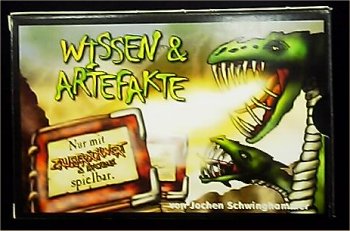 Marching on from the TENKIGAMES booth I made a short stop at the cardgames publisher ADLUNG which had created the fascinating KUTSCHFAHRT ZUR TEUFELSBURG two years ago. I bought at their booth the newest expansion for their fantasy cardgame Zauberschwert und Drachenei, and with Wissen und Artefakte now finally a sixth player would be able to participate in the game. Also, I was told that there was a high possibility for a Kutschfahrt-Expansion to be released next year, and so it will be quite interesting to see how this game may be spiced up even more. 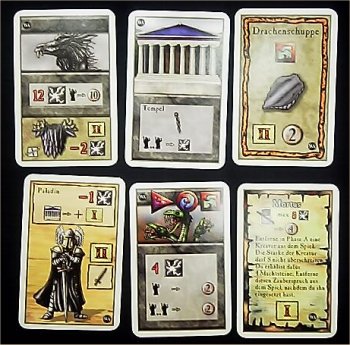 The interesting start with Comuni actually had awakened an idea to do an "Italian Day" today, an so I thought it would be a nice idea to have a look at some other promising games from Italian publishers. During my reports from the SPIEL 07 I had introduced to you the newly founded publisher GIOCHIX which had brought to Essen the interesting new cardgame Medievalia. This year GIOCHIX has returned, and as it seems last year's debut to the world of games has been successful since now they have brought with them their first boardgame: One more Barrel Quite daringly, Michele Quondam has taken the War in Iraq as a topic for his new game, but instead of creating a somewhat outdated pure wargame Michele has instead presented a snappy persiflage which focuses on the gaining of oil. An interesting angle, and already the derisive cover art of the gamebox suggests that the game might be quite unusual. 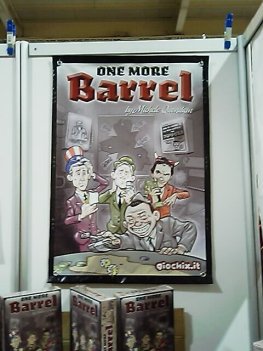 Three to five players may participate in the game, and it is split into 12 to 15 rounds (depending on the number of players). Each third of the game is played under a different heading: Invasion, Guerrilla and Transitional Government. So, at the beginning all the players will receive is a stockpile of troop markers and 10 $ which they may use to finance their campaign against an "independent oil-producing country". During each turn of the game the players will have the possibility to chose two actions: purchasing troops, constructing buildings, investing in the Mass Media or in Influence, producing Oil, taking money, levying taxes, moving troops and Logistics, becoming next starting player etc. However, some of the actions are limited, and beginning with the starting player each player first choses one action and performs it before each player choses and performs his second action. Also, the first player(s) to chose an action always will be better off than later players since the actions will get less powerful the more players have used them in a round. Troops and Logistics can be purchased with money, and the troops then may be sent on a mission of conquest, invading the target country by crossing its southwestern border. Entering the different provinces of the target country, the troops of the players first will be faced with defending national army units, their number depending on the oil-production capabilities of the invaded province. In addition, during the Invasion phase of the game the old government of the target country still is in a position of relative power, and so during this phase the defending troops will receive an additional bonus which is determined by the roll of a dice. Battle then is decided by calculating the quota between attacking and defending troops, rolling a dice and cross-referencing the result on a battle chart in order to find out how may units of both sides have been destroyed. Thus, during the course of the game the players will slowly gain control of the 17 provinces of the target country by moving their troops and logistics into position. Since the players have taken the roles of different nations who have formed an Alliance to bring down the government of the target country, no direct combat is allowed between the forces of the players. Instead, they may move freely through the provinces controlled by each other, and they may even agree to form multinational forces to free some of the stronger provinces. The more troops a player has on the gameboard, the more people will join the Pacifist movement in the player's home country. Thus, the gameboard features a scale for Pacifism which will be increased if a player acquires new troops, if troops are lost in battle, if a terrorist bombing is successful or if a player decides to levy additional taxes to finance his campaign. The number of troops a player may keep without rising Pacifism can be counterbalanced by investing in the Mass Media, but even this will not fully prevent a full rise of Pacifism. Here a recurring harmful effect is that, at the end of a round, each player will have to pay a penalty depending on his current level of Pacifism. Once a province is under control of a player, he may start to produce oil if he has enough units of Logistics present in the province. As said, each province has a capacity for producing oil barrels (ranging between 1 and 5), but to make use of the production a player also has to move in a certain amount of Logistics. Only if the required number of Logistics is present the province will start to produce oil, and during each turn in which oil is produced one unit of Logistics will be consumed. Here the provinces are structured in a way that the players first will have top invade provinces with a low Logistics-for-oil output-quota, whereas the provinces with the better production rates will be reached in later turns. Two barrels of produced oil may be taken to a player's personal stockpile each turn, whereas the rest of the produced oil needs to be stored in the province where it was produced. Normally, a province only can store one barrel of oil, so that any excess barrels will be lost. However, here another usage of Logistics becomes important: the construction of Military Buildings. Four kinds of Military Buildings are available at different costs:
It is important for a player to collect Oil in his personal stockpile, since only Oil from this pool may be sold at the international market. At the beginning of the game the Oil price starts on the lowest space of the price scale (0.5 per barrel), but at the end of a round the players will have to check whether the Oil price is adjusted. So, the Oil price will rise by one if no player has sold Oil during this round, but it will drop by one or more spaces if one or more players have sold Oil during the round. Also, another use for the Pacifism scale of the players becomes visible, since the player with the highest Pacifism score now will have to check his scale for the speculation level of the current Round. The higher the Pacifism level is, the more the Oil price will go up due to increased speculation. 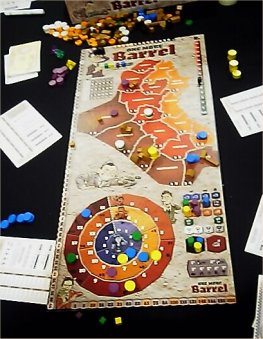 During the Guerrilla phase of the game each player will receive a unit of rebels which will enter the target country over the northeastern border. These units of terrorists will slowly gain strength, and the players may use them to sabotage the actions of each other by bombings. A successful bombing may result in the loss of Logistics, troops or even Military Buildings of the victim player, and with this the victim will have to increase his level of Pacifism. However, such an attack will get more difficult if a player has invested in building Police Stations. Also, when making purchases a player may opt to remove one units of Logistics in order to gain Influence with the population, and the more Influence a player possesses the more difficult it will get for the rebels to make a successful strike. On the other hand, the presence of a massive amount of troops in a province offers more targets, and this will make a strike somewhat easier. And just like players may combine their troops in order to attack a province, players also may opt to unite their rebel units against a common target in order to ensure success. The final third of the game runs under the heading Transitional Government, and in this phase the end of turn sequence is extended by an additional production phase. In this phase each player must produce Oil in all of his provinces, and half of the Oil produced will be given to the Transitional Government of the target country. If a player cannot produce Oil in a province, he will lose an Influence point (or pay a monetary penalty in case his influence level is zero). The Oil gained by the Transitional Government will be distributed at the end of the game, and here the level of participation of each player depends on his Influence level and the number of provinces he controls. As said, the game automatically ends after the last round of the Transitional Government phase, and now all players convert their remaining Oil reserves (on and off-board) into cash for the last current Oil price. Some specific bonus is added, and a Penalty must be paid according the each player's Pacifism level multiplied by 10! The player with most money then has won the game. Phew, the game definitely offers a lot of fine-tuned interactions between its different elements, and players certainly need to get used to the playing mechanism before they fully can enjoy the considerable playing depth which can be found in One more Barrel. This also makes the game difficult to explain to newcomers, since a good handling of the rules is mandatory to make the right use of the different options available to a player. Thus, I also checked out the rulebook to see how well the rules were presented there, since last year the rulebooks of the new GIOCHIX cardgames did have a few ambiguous passages which left a few questions open. However, with this new boardgame the translators have done a better job, and while it is true that the general structure of the rules is a bit cumbersome at first, all needed information can be found (somewhere….) . As indicated, the game offers a quite daring graphical design, and overall all the components come at a very high production standard which make it difficult to distinguish this game from a product of a major producer. The plain woodedn disks which serve as troops put emphasis on the level of abstraction, but I am sure that players who like a bit more realistic playing pieces will make use of figures from either Memoir '44 or Axis & Allies Overall, Michele Quondam created a tough strategic boardgame for serious hobbyists, and to my estimation experienced players will find a good challenge in the task to become the nation who is most successful in this "war for profit". And in the end, the rules could not find a better last sentence: Play Games, Not War! 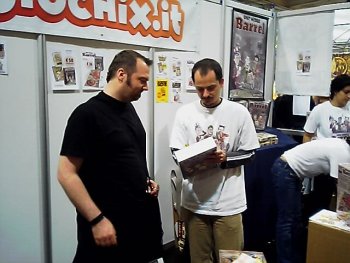 Sometimes after playtesting a game I wanted to see I just let my feet go freely and take me to a section of the convention area where I have not planned to go for a specific reason, and once again this year showed that this gives me an opportunity to stumble over somewhat obscure games which I would have missed otherwise. Today, I left the booth of GIOCHIX and turned towards the general direction of Hall 4 in which I wanted to check out another game, but in the connecting corridor I decided to make a small detour into Hall 6 where most of the Life Role Playing stuff and fantasy games traders are located. From previous years I had the knowledge that sometimes the Merz-Verlag would place some smaller publishers at the end of the convention area behind the life role playing accessories, and there I came upon the booth of the small Spanish publisher GenX GAMES. Looking tremendously complex, my eye fell upon the science-fiction boardgame Mecanisburgo, and the look of the rather impressive load of differently illustrated character and item cards around the futuristic gameboard made me quite eager to learn more about the game. In Mecanisburgo, the players assume the management of Mega-Corporations which are all present in largest Metropolis of the Western world, and there they battle each other for power and influential projects to become the ultimate controller of the planetary economy. To reach this target, each player receives a boardroom-gameboard of his own where three starting characters (the directors) of his corporation are placed, but there is always room in and around the boardroom for a total of up to 8 characters, so that the players may hire new characters during the course of the game. In addition, each player also receives some fixed benefit cards and draws a few cards from the central "Opportunities"-pile, and of these cards he may keep some cards up to a certain value as starting resources of his corporation. The Opportunities pile actually contains new characters and items which might be useful for the players, but it also contains some events and threats which will be ignored at the setup-phase. However, once the game has started, all nine locations on the gameboard will be filled with cards drawn from the Opportunities pile, and now events and threats may come into the game just like new characters or items. Each location on the gameboard receives one card, and then the players will start their deployment phase. The players have pawns for each of their agents, and the pawns cannot be recognized without looking at there bottom where a number is printed which corresponds to the slot a character card occupied in a player's boardroom. Thus, in the deployment phase the players in turn place their characters one by one into one or more locations, and nobody knows how the other players will have sent to the same locations. Once the deployment is over, all locations with characters of only one player will be dominated by that player for this round, whereas all locations with more than one player's agents present will need to face a conflict resolution. The character cards usually display different values for negotiation and combat skills, and the first player to have sent an agent to a location will decide whether aconflict will be decided by combat or by negotiation. The players add up the corresponding value of their leading character with the support values of possibly present additional characters, and they may also use certain properties to increase their value even further. In addition, a character may be removed from the game if an opposing character actually uses his assassination skill on him, once again reducing a player's score. To get the final scores the players actually are allowed to chose an additional action card (with different values), but on the other hand all unused action cards will give the player bonus income at the end of the round. Thus, a decision must be made whether to use a card or to save it to create a higher income. After all conflicts have been dealt with at each location only the characters of one player will be present, and that player now will have the opportunity to use that place's special function this turn and to gain access to the Opportunity card which has been placed there. New characters can be hired and property can be acquired in order to boost up a corporation's resources, and then the final steps of the round will be dealt with. So, the players will receive their income, pay all their characters the required wages (or discard them) and make repairs. However, most important is the investment into Major Projects the cards of which are displayed on the table, since these projects actually will bring high amounts of victory points which are needed to win the game. However, these projects cannot simply be purchased, since many of them have pre-requirements in terms of money, , professions, skills and property which must be owned in order to get the major project. Talking about character's profession and skills we have actually come to the first dimension where playing depth is increased. There exists a considerable number of different professions and skills which can be found as symbols on the different character cards, and each of these skills actually confers certain benefits for the player. For example, Executives can increase income, Security officers make an assassination more difficult, Technicans gain additional support from Robots present in a confrontation, or a lawyer may sue and remove a criminal character of another player from the game. Some of these professions actually just require a certain situation to arise, whereas others require a character to be present at a special location. So, the Lawyer only can use his special skill at the Palacio die Justicia, whereas an Autowarrior can participate in an Autocombat night in the Anficiico arena. Skills are varied likewise, and so the characters may have special options in terms of seduction, hacking, socializing, assassination or sabotage. At this stage it becomes clear that Mecanisburgo is a game of considerable playing depth, since a look at the overview sheets available to each player reveals that quite a lot of specialization is possible by the possession of the different characters. The next dimension then is added by the nine different locations, since once again all of these locations offer special powers which can be used to the benefit of the player who controls them. So, players in the Casino complex can seduce other players' characters at a wider range, the Spaceport offers control of space traffic for the ongoing round, or the Financial complex offers business income and an additional, secret opportunities card. The treatment of the locations also goes hand in hand with the different corporations available to the players, since the players may get benefits in certain locations depending on which corporation they represent. And as a further interwoven connection the Major projects which a corporation may acquire (if it has the right professions, skills and financial resources) will not only bring good victory point and bonus points for certain possessions at the end of the game, but many of these cards actually may have some associated bonus which will be applicable during the course of the game. The game only has a playing duration of four turns, but within these four turns quite a bit of action and interaction will happen between the players. After four rounds, victory will be gained by the player with most victory points out of his corporation's assets, but at the beginning of turns three and four victory event cards will be revealed which offer special alternate victory conditions. And even more, a special combination of Opportunity cards may ensure an alternate victory as well. However, victory of a player is not altogether certain, since some great threats exist in the Opportunities deck which may actually wipe out the whole city (and the player's with it). And so a Giant Beast or a Robot Rebellion might destroy too many locations so that the game is lost by all players, whereas the fearful Triunvirus may spread and kill loads of characters. The appearance of a threat always will detract the players from their current issues, but apart from preventing an early ending of the game it usually pays off for a corporation in terms of victory points to be responsible for the saving of the city. On the other hand, a player who sees himself loosing the game actually may seize the opportunity to further the chaos by occupying spaces at the location of the threat and holding them against other players, so that possibly the other players' victory can be prevented by a cataclysm. Mecanisburgo by no means is a light game (even in the literal sense since the small gamebox actually has a weight of about 2 kilos!), and I was rather happy to have the game explained to me by the author at the SPIEL convention. Still, in comparison to older games by SPI or AVALON HILL which offer a comparable degree of complexity Mecanisburgo actually shows that modern ways to design cards and components actually can help, since the fitting symbolism is used on board and cards can be used quite well in conjunction with the player's overview cards. The structure of the rules tries to be helpful here as well, since they offer appendix sections which are meant to keep the players from searching for certain passages in the main body of the text. Nonetheless, the degree of complexity which can be found in Mecanisburgo was intended and the players who will invest the necessary time will finde a quite intriguing game of politics and power, and the assembly of a player's corporation by outfitting it with characters and resources (and keeping it up by paying for it) is a rather challenging and interesting task. Many ways can be explored by which victory could be possible, and since the game comes with over 150 individual cards with quite stunning artwork (in comparison: Dominion has 31 different cards, including money) a very high replay value should be found with Mecanisburgo. 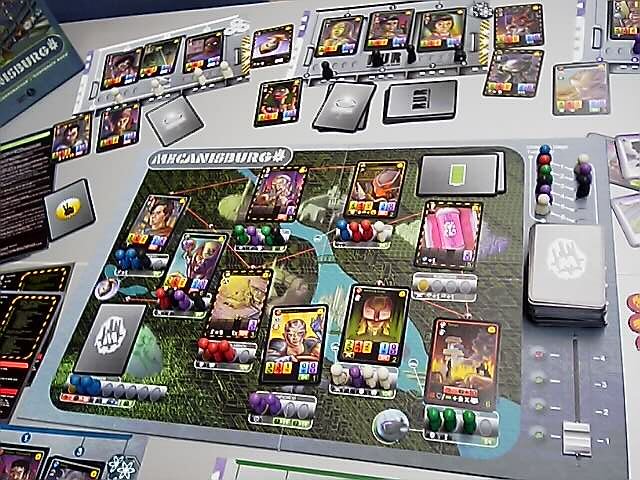 I have always been quite fond of Um Reifenbreite, winner of the Spiel des Jahres awards of the year 1992. I have been looking for a good game about a cycling race ever since, and this year I heard that finally the Italian publisher GHENOS GAMES has made a new bid to publish a cycling game. At the booth of GHENOS I found a rather eyecatching diorama-version of Leader 1 on display, but the playing components in the gamebox actually do look very nice as well. A total of 21 big hexagonal spaces is included for the players to build up their own racing tracks, and the border of each of the street sections actually depicts whether it is a road on a flat plain, a moderate ground rise, a mountain pass or a downhill section. Also included is a set of 15 small painted plastic bikers (three figures for each team), and several tokens, cards, tiles and other items which will be used during the game. 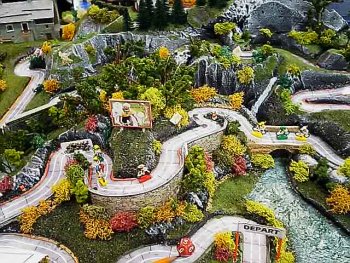 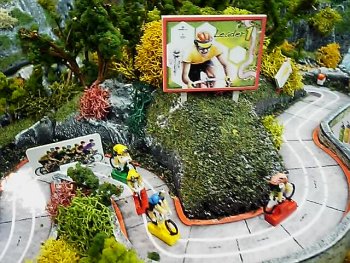 When setting up the hexagon tiles for the present race the track layout needs to follow certain conditions, so that a mountain pass actually must be preceded by a ground rise and that the track must be begun and ended with start and finish hexagons. Next to the beginning of each mountain pass section a token for the category of this mountain must be placed, and also one or more feeded areas where the players will get new waterbottles will be spread fairly evenly among the track. Normally each player will receive a team of three bikers, and the character of these figures can be distinguished by the colour of their stands. So, a figure with a yellow base will be the leader of the team, whereas a red base identifies a climber and a green base a rouleur (specialist for flat terrain). However, if a higher number of players participated the players actually may be forced to use less bikers so that enough figures will be available for everybody. According to the games author who stood by and explained the game this is going to created somewhat faster races, but the temporary alliances which will be formed also will lead to some disagreements around the table. However, the figures of the bikers will not be placed on the Start-board at the beginning of the game, but instead one special standup figure for the Peloton (the main body of bikers) will be placed at the start. During each round of play one player will be in control of the Peloton, rolling a special dice to see how far the Peloton will be moved forwards. In addition, this player also may determine that the Peloton speeds up, meaning that it will move one step more than indicated by the dice roll and all bikers still present in the Peloton will have to spend an energy-point. Energy points for each of a player's bikers are recorded on a special record sheet, and at the beginning each of a player's figures has a starting energy reserve of 50 points. In addition, the players also are allowed to make one of their figures a downhill specialist at the beginning of the game, and another one may become a sprinter. Before the Peloton is moved all players will be asked whether one or more of their figures will try to break away from the Peloton, and to make a breakaway a figure needs to be moved to a position at least four steps ahead of the Peloton. The regular movement of a figure depends on the type of road occupied at the beginning, and all figures will get two free moves on a moderate ground rise. Differences apply to plains and mountain passes, and a climber moves three free moves on a mountain pass and one on the plains, whereas a rouleur moves three steps on the plains and one on the mountain pass. The team leader actually is a fairly even character, and so he receives two free moves on any terrain. However, one more exception applies to all figures, in this is a downhill section where four free moves may be made. Usually the number of free moves will not be sufficient for a player to get away from the Peloton or to keep up with the leading figures, so he will need to spend one or more of the biker's energy points to move the figure some additional steps. One additional step may be moved for each point of energy spent, but this kind of forced movement will quickly drain a biker's resources. However, some further possibilities for free moves exist, and so a biker with the downhill ability receives an additional free move on a downhill section and a sprinter gets a free move on the final section leading to the finish. Furthermore, there is a slipstream effect if a biker starts was positioned directly behind another biker after its previous move, and the slipstream also will give the biker one free move for his current move. However, a cycling race would not be complete without some hazards, and thus there are certain situations in which a danger may arise. So, the players should be awards of the category of each mountain pass their bikers are ascending, since the category of the pass actually defines how many energy tokens a biker may spend each turn without the risk of a breakdown. If the biker spends more energy he will have to make a risk-roll (with the risk factor being increased for each risk taken in the race), and if the risk roll is a failure the biker will suffer a breakdown and the move will cost him thrice the required energy points. There also exist some possible fall-spaces on the downhill sections, and if a biker passes such a fall-space when spending energy points for movements he will need to make a risk roll as well. Here the risk roll also results in the loss of energy, but the biker also must skip one turn to get back onto his bike. Waterbottle-cards with new energy can be gained at feed zones along the track, and these cards may be kept secret till later in the race to make a possible surprise movement with secret energy reserves. However, it is also possible that a biker cannot (or does not wantt o) stay ahead of the Peloton any longer, and if a biker is captured by the Peloton his figure once again will be removed from the track. And as said earlier, the player who currently leads the Peloton actually may speed it up for one step, forcing all bikers in the Peloton to lose an energy point. If a biker cannot even pay this one point, his figure will fall out of the Peloton and he will go behind. The game ends when the end of the track is reached, and here the players actually may decide whether they want to create something like a scoring table for the different positions in the final classment. The rules of the game make no suggestions here, so that the final classment rules from Um Reifenbreite actually might fit quite well. Speaking more general, up to this point I did not see much of a difference concerning playing quality between Leader 1 and Um Reifenbreite, because the rules of both games may, but at the same time they are comparatively even in terms of complexity and realism. To my mind the slipstream rules and team management are more pronounced in Um Reifenbreite, but Leader 1 actually has a lead in terms of normal movement and hazard rules. However, the final section of the rulebook actually features some rules which make Leader 1 finish the race first, and this section of the rules is actually concerned with a race over multiple stages. Here a token for each biker is placed on a circular "general classification" scoretrack, and each of the bikers actually will win or lose points depening on his current classment. So, the token of a biker who wins a race is moved two steps forwards, whereas the tokens of all bikers who arrive after the winner will be moved backwards for as many spaces as it took them turns to arrive at the finish behind the winner. Only bikers who finish in the same turn as the winner will avoid this penalty. Additional bonus time tokens may be collected among the track (representing mountain points or a sprint), but some factors also may lead to a removal of a biker from the game. Thus, a biker who finishes more than three turns after the Peloton will be disqualified, and likewise a biker whose token on the classification is overtaken by the leading player will be removed. As a final touch, bikers also may transfer up to 15 remaining energy as a bonus into the next race, and in the end the winner will be the leader in the classment after the agreed number of races. To my mind Leader 1 will present its full flavour if played in this "Stage Race" mode, since here the players can use different tracks for each stage of the race and strategic planning becomes more important in order not to lose a biker due to a disqualification and to (possibly) save energy points for the next race. This playing modus actually will require quite a bit more playing time than a single race, but players who have gotten a general grip on the game's mechanics should find this prolonged challenge rather tempting. Myself, I rather enjoy the fact that I finally have a new, nicely designed cycling race game with flexible tracks after spending years and years on the rather fixed track of Um Reifenbreite. Allez les coureurs !!! 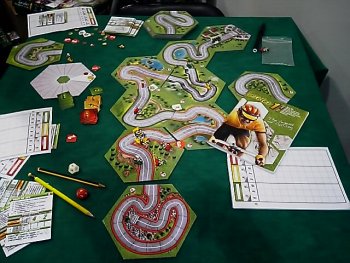 Well, and with this I am going to leave you for today, because Ralf had a day off with his family. But me and Ralf will be back for our final reports tomorrow, so do not miss the grand final of this year's SPIEL reports. It's great to have the daylight-saving time change here in Europe tonight. The clocks are moved one hour backwards, and this gives me an additional hour of sleep. Hurray!!! Sunday, 26th of October - FINAL DAY !!!Wow, a week has passed, and once again you have reached the final day of my Essen-reports. The convention week always passes so fast, but there were still some games which I had to playtest and tell you about. However, before I retrace my steps let's have a look at what Ralf was doing today! 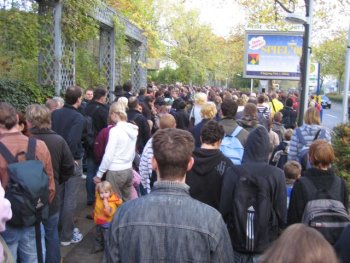 "After my day off yesterday, I am back again for the final day of this year´s convention in Essen. As always, I expected the weekend days to be extremely crowded and so it was. Beginning with the ticket office you could find queues at every booth. Especially the booths where you could buy games with more or less interesting offers, could no longer hold back the masses. As if there were no shops in town and no internet to order new games, the people looked and bought like hell." 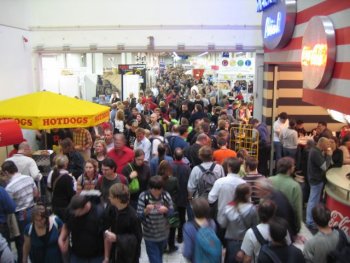 "I had other things to do today and had luck to find a free seat at the HANS IM GLÜCK booth. My other players were experienced gamers, too, and so we understood the rules quickly and easily found into the games." "Our first try was a round of PALAIS ROYAL. In the game the players send out their servants to the different rooms of the Palais. These rooms can be arranged in any order under the gameboard which give the players several possibilities to influence the game. Each room has a special function. To use this function in a turn the player must have at least one of his servants in the room. The aim of PALAIS ROYAL is to wow the nobles on the main board. This is done with the help of money, and two different types (red and turquoise) of seals that only can be used if the player has the necessary number of servants in the corresponding rooms." "Each turn begins by placing as many new servants from a players´ reserve in the room with the gate of the Palais as the players´ number of servants in another room whose exact name I do not remember. In the next phase the servants can be moved to adjacent rooms. The number of possible moves again is defined by the number of servants in a third room. Money is given to the players in the same manner. The more servants a player has in the right room, the more money the player will get. Then the seals are guaranteed to servants in the right rooms. Servants who have the majority in a room give a bonus, for example another seal or an additional move. If there is a draw then the majority of another room decides which player gets the bonus." "After that the time of wowing has come. Nobles on the main board can be taken with the right amount of money and number of seals. The seals are not given to the players but hold by the servants in the rooms. Thus, by taking a noble, the servants in the rooms are taken back to the reserve again. Some nobles guarantee the players special abilities, so for example two steps more in the moving phase." "The game seems to be little bit tricky at the start. I guess that players without experience would not really have a chance to win the game, because some of the special abilities of the nobles are very helpful but the number of these is limited, too. In our round, my right opponent easily won the game, after he had taken the right nobles (coincidentally) right at the beginning. If all players know the game, it is a typical game of limitations, because your servants soon will come back to you by different actions and the servants are missing in the rooms. The distribution of the servants in the moving phase dominates the possible moves in the next phases. The game seems to work very well, but I had the feeling that a little bit more interaction would do the game no harm". 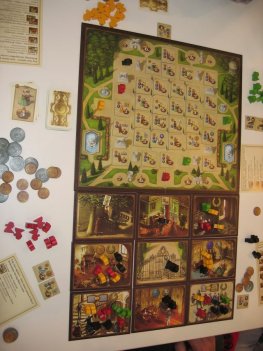 "While the crowd moved around us, we decided to remain seated and took another game from HANS IM GLÜCK. This was the newest variant of CARCASSONNE, CARCASSONNE MAYFLOWER. This time the settlers conquer America. Starting at the east side they move forward to the west. The game is very similar to the original CARCASSONNE and the other variants. Victory points are given for ways, cities, farms and grazing lands. New in the game are two surveyors who are moved one column to the west each time a construction has been finished. Once the surveyors both have passed settlers on the board (with an exception of settlers on the grazing land) these settlers are removed (i.e. settlers that are eastward from the surveyors). This gives the game a very strong new aspect. The surveyors prevent the players to build their own cities somewhere in the nowhere. There is also the tendency to finish the buildings much earlier. We liked the variant very much, the only disadvantage was that the table quickly was getting too short, because we rapidly moved to the west to get out of the way of the surveyors." 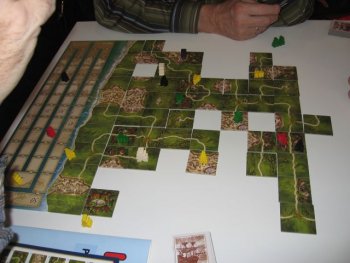 "Two and a half hours later I left the booth and had a walk to some halls and booths I had no time to see the other days before. Nearly one whole hall was reserved for LARP and here you could buy armors, blades and all the other stuff you need for the next contest. Yesterday, when the weather was better, a considerable bunch of these LARP-players actually used the inner courtyard of the convention area for a big tournament, and there was a great crowd of spectators who had watched the show." 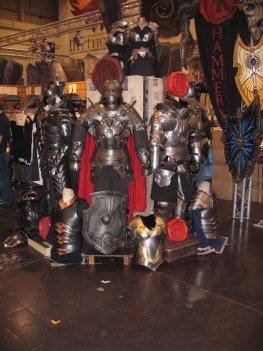 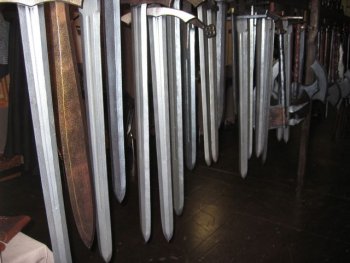 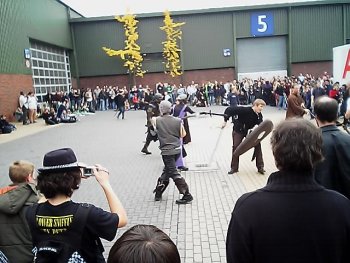 "But that was not my object of desire and so I left the hall, moved along the comic booths and went once again to PEGASUS where I found a new variant of Wolfgang Kramer´s TOP RACE. This game still can enthuse people, especially in the modern look of Pegasus. But at this convention the game had strong competitors. Wherever you looked you could find a racing game, either motorsport, bikes or bicycles. So maybe my old UM REIFENBREITE will get a longer pause in the next years." 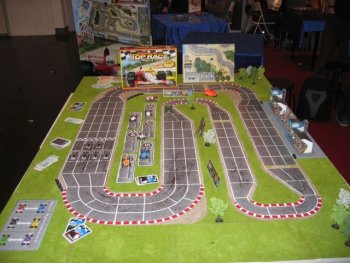 "Moving around, I finally had a break at the big booth of Amodée and Days of Wonder. After some problems with the first distributer AT-43 by RACKHAM is now distributed by Asmodée in Germany, too. The tabletop game is already very successful in the USA. I had a brief introduction on the booth. The game mechanism can be compared with WARHAMMER, but the figures are plastics and are prepainted which saves some time for playing the game. Until now there are four different races, two of them human and two aliens. On the website www.AT-43.com you can find more information and also a free download for the rules. What I saw at the booth was already quite promising." 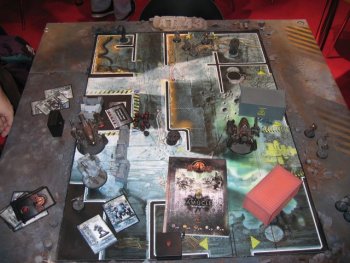 "Back to Kosmos´ booth I was still not able to do a test of DER HEXER VON SALEM due to a very huge crowd, but I listened to the rules and watched some turns of play. Like in ARKHAM HORROR the players try to lock the gates to the outer world in Arkham together. In this game there are seven buildings where creatures of the dark appear to threaten the people of Arkham and the players. Creatures can be beaten with the help of the right equipment (which is indicated on the card of the creature). There are seven items the players can buy at the buildings after revealing a new creature, moving and fighting against creatures in the same building. Items are bought by reducing abilities of the player, taking a new creature or revealing an event card which influences the game. The last possibility to pay an item is moving Necron, the evil magician, one or two steps forward. After all players have done their turn, another event card is revealed. Then the sorcerer of Salem is moved along the buildings and the event is read and executed. This sorcerer helps the players on the same building in the next turn. There are six different old ones in DER HEXER VON SALEM and the player have to defeat all of them, to win the game. The last old one has to be banned by one player, while the others try to close the final gate to the outer world. There is only one way to win the game, but the players can lose the game in three different ways. Necron must not move to his final field and of course there is also the chance that all players died before the final battle. Players on the convention seemed to be very content with the game, but I wonder whether they had played ARKHAM HORROR before. DER HEXER VON SALEM adopts the same theme and the game mechanism is similar, too. On the other hand the complexity and the possibilities of the players are considerable more limited. So the latter game is more for the mainstream mass, while ARHAM HORROR attracts the experienced gamers who don´t fear more complex rules". "Nevertheless DER HEXER VON SALEM looks like a good game and as the game is worth to have a closer look, I promised Frank that I would do a heavy test against ARKHAM HORROR in the next weeks and write a detailed review. So check for updates in the next time." So now there is the time to say goodbye for me to this years´ convention. I had a lot of fun, found many interesting games and tried to give you some feeling of the atmosphere here in Essen (even if I can´t beat Franks enormously depth of information and details). Stay tuned at the website in the next weeks when I give you one review or another. Bye, bye… " I am rather thankful that I got Ralf's help this year during the convention days because our combined efforts actually allowed me to present you with a good, somewhat representative overview of the show. Considering the choice I had to make between 550 new games I felt nearly overwhelmed, and so I could spread a bit of the coverage onto another pair of shoulders. But let's now start with my own day's doing! 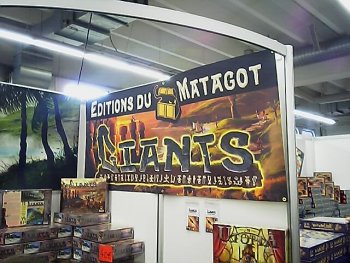 A publisher which is quite famous for its fabulous looking games is MATAGOT from France, and as it seems this year they have outdone themselves. Before the SPIEL images of their new game Giants were circulated only very sparingly, and after seeing the teaser on their website and learning that the game actually would be about the huge stone statues (Moai), I was rather eager to see this game. And indeed, upon setting my eyes upon this game I was rather impressed of the level of graphical perfection which had been reached. Very nice figures of the Moai (and their Pukao hats), three different kinds of tribal figures for each of the five tribes (players), and a stunningly beautiful gameboard. This game is setting a standard which can hardly be improved upon, and for me it is definitely the most beautiful game of the convention. The game itself is about the erection of the Moai along the outer coast of the island. The figures all are produced in a quarry which is situated far in the western half of the island, whereas their final positions are marked hexagonal squares all along the coast. The more remote a building site is from a quarry, the more victory points a player will score if he succeeds in erecting a Moai there, and these victory points actually will be multiplied by two or three if the player does not build a small Moai but a medium sized or a large one. But how does the who process work? The tribe of each player has a Chief, a Shaman and normal tribe members (I will term them Workers). At the beginning of a round the players roll a hand of dice (their number corresponding to the number of players), and these dice determine which kinds of Moai will be available for the round. The players then take a number of workers ranging from one to three into their hand and reveal them simultaneously. The size of a players workforce determines the size of the Moai a player can build, but the order in which the players may chose is depending on the current start player and on the fact whether the players have bet tribal tokens as well. A player who has bet tribal tokens may chose first, and then the rest of the players may chose in playing order, beginning with the start player. This procedure may result in the fact that some players may not be able to take a Moai this round because the cheaper smaller Moai might have been taken by earlier players so that the bigger Moai possibly could not be afforded. All workers and tribal tokens used in this auction will remain in front of a player's viewscreen so that the player is not allowed to use them for anything else during the rest of the turn, but he will get all of them back when the turn is over. The auction is followed by the placement phase in which the players in turn either place one of their figures or put another tribal token in front of their screen in order to indicate that they want to skip placement to the next player. This might be useful to get a more developed situation on the gameboard so that placement of a figure can be calculated better. Also, a player who skips receives a Rune tablet. The Moai now will need to be transported from the quarry to their final positions, and the number of workers which needs to be present in each space to ensure that the Moai can be moved forwards depends on the size of the Moai. So, a small Moai only needs one worker, whereas a big Moai needs three workers to be moved. Here the workers of all players are cooperating, so that three workers from different players actually are enough that is needed to move a fourth player's Moai. However, each worker how has been used on the transport route of a Moai will bring its player a victory point. The Ciefs of the tribes are very strong, and they actually can do the work of three men. Thus, during the placement of the figures routed for the Moai will be developed, and a Moai then may be moved as far as there are enough workers to move him. All the owner of a Moai needs is one of his own figures on the space before the desired building site. This allows him to stand up the Moai on the desired site, marking it with a face-down tile depicting his tribe symbol. However, the whole process of building and transporting firsts needs to receive a higher number of workers before larger distances can be bridged. Here the players have to build up a force of workers, since each player only possesses one worker at the beginning of the game. The Shaman of a tribe may be used to organise new workers, and so a player receive a new worker for his force when he puts his Shaman into the village. Actually, the village is not the only place where the Shaman can be placed, and so he may also be used in the workshop to produce an additional tribal token, in the forest to get some trees felled, or at another quarry at the eastern half of the island where he produces a hat for one of the Moai. Furthermore, the Shaman also may be sent to a building site, allowing a player ro reserve the site for one of his Moai in the future. The Chief actually may also function as a Shaman, but to make use of one of the Shaman's actions with the Chief the player must additionally discard two Rune tablets. The trees which a player acquires actually can be placed together with a worker, and each tree in a space actually reduces the number of workers needed to transport a Moai by one (moving the heavy stone by rolling the trees). However, this benefit is only temporary, and the trees will be removed after the round. The hats on the other hand need to be transported with workers just like the Moai, but only one worker is needed in each space to transport a hat. If a Moai receives a hat the player who has built that Moai will receive additional victory points at the end of the game, and once again the number of victory points depends on the distance between the quarry for the hats and the final position of the Moai. The game ends when a player has placed his fifth Moai (in a five-player-game), and then the tokens will be revealed which show who had placed which Moai. The victory points will be added up and the player with most points has won the game. I had playtested Giants together with Chris Leonhard whom I had met on my way to the MATAGOT booth, and after the game we both agreed that the game functions rather well. For me, it is hard to remember any games from the last few years which actually had a story line which was followed by the rules to such a high degree. The different actions available to the players correspond rather well with the general background of the erection of the Moai, and this makes of Giants an impressively whole game. At the beginning most of the players naturally will focus on building up their workforce, but the way in which they might plan to win the game will differ by some degrees as the game progresses. So, some players might try to build some cheap Moai rather soon in order to go for valuable hats, whereas others might try to get their Moai moved to far-away places. This brings up competition and makes the players look for upcoming opportunities, and keeps the game rather entertaining for the whole playing time. 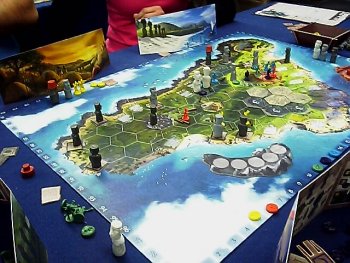 After playtesting Giants I decided to make my way back to the halls with the major publishers, but I actually decided to take a little detour through halls 6 and 4 in order to have another look for some curiosity which I might have missed. And there it was: at a private booth run by a team of Italians I saw a fantasy adventure game which was sold in a cute looking little wooden box. On first sight the game Telendar by Christian Piovano actually might have been a travel edition of Talisman with the different card decks and the stand-up character figures, and so I was hooked and sat down in order to have a closer look at the game. 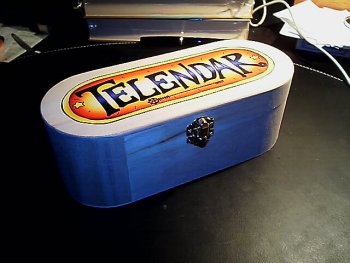 The comic-style artwork used by Christian actually is somewhat naive, but actually it's rather nice looking and fits the nature of this small game. The gameboard is made up of 49 landscape tiles, and all of the tiles are placed face down on the table in a 7 times 7 grid. An exception are the four cities and villages which are placed at the four corners of the playing area, and the nine center tiles actually are special cursed territories, amongst them the Gates of Hell which the players aim to close in order to win the game. A Hero may try to close the gates if he should find a special key, but there is a time limit in which the game either must be won by a player or will be lost by all. The old King of the land of Telendar is slowly dying, and every turn the players need to reveal an event card which either shows a general event or a further deterioration of the King's health. With every lifepoint the King loses the players will suffer some change of rules, and whereas at first the will of the King still holds so that the players actually will face some beneficial playing conditions, there will come a point when the rules will start to turn to the players' detriment. And when the King dies the Kingdom will fall in turmoil and will be unable to restrain the forces of Chaos which keep coming through the Gate. Several decks of cards are placed at hand at the beginning of the game, and some of these decks are shuffled like the Events, Treasures, Common and Cursed cards, whereas other sets of cards simply will be placed at hand and looked through for certain cards in the course of the game. Each player will receive a character figure., and the main characteristics of each adventurer are Strength, Mana and Hit Points. Also, each character has a small special ability, and the starting ratings of the different characteristics will vary depending on the profession of the characters. The current characteristics of the characters are recorded with coloured chips, but a quite useful idea has been to turn lost Hit Points and Mana just on their backside whenever they are lost. This way the maximum of each characteristic remains visible, and whenever Hit Points or healed or Mana is replenished at the beginning of a player's turn the chips simply will be turned up again. The players will move their characters through the Kingdom, and they must stop whenever they either reach an unexplored tile or, when moving over revealed tiles, when they reach a forest. An unexplored tile will be turned face up, and after a possible revealing of the landscape the player will have to drawn an adventure card from the corresponding deck if no card is present ion the tile, provided there are no special places or fixed monsters printed on the tile. Special places will give the players different opportunities to gain cards and attributes, whereas fixed monsters require a certain monster card to be placed on the tile which needed to be sorted out of the cards placed at hand. Combat with any encountered monster then is dealt with in the good old fashion of many adventure games, with the player rolling dice for himself and the monster, both adding their strength ratings and possible equipment bonuses. A lost combat means the loss of Hit points equal to the difference between the two combat scores, but if the player actually succeeds in slaying a monster with a higher strength rating he will gain an additional strength point himself, but all characteristics never may surpass their start rating by more than eight points. Some monsters also carry special artefacts with them, and when the monster is slain the cards for these artefacts once again need to be found in the cards placed at hand and they can be claimed by the winning character. Other items may be bought in settlements, and here the players also may get healed or they can purchase an increase of one of their characteristics. A quite cute idea also is the fact that some of the slain monsters or animals actually may leave some kind of ingredient which the player scan take them and, if they should encounter the landscape with the magic cauldron, use to brew a potion which might give them an additional increase of one or more characteristics. The more ingredients are collected the stronger the potion will become. As said, the game only can be won by closing the Gates of hell with one of the lost key, and these key can be found with the fixed monsters on several landscape tiles. These monsters are much stronger than the monsters which are usually encountered in the game, and a higher number of them actually exists on the cursed landscapes in the middle of the Kingdom. If a player should succeed in claiming such a key and reaches the Gates of Hell, he will have to roll and dice and the key only operates successful if a certain minimum number can be rolled. This number is depending on the power of the fixed monster from which the key was gained, and if the key cannot be operated successfully it will break and the player must start to look for another key. However, if the gates can be successfully closed the player who has performed the deep will be declared to be the winner of the game. Telendar actually includes all elements which are needed for a nice adventure game, and it is absolutely surprising to see the number of components which could be fit into the tiny gamebox. However, what I especially like about the game is its flexible gameboard which is created anew whenever a new game is played, and furthermore the several ways which the players actually may try to get into a position to win the game. On the one hand the traditional "gain-strength-through-combat" way is open, but on the other hand players also may try to get money by trading some items so that they can afford to purchase increases of their characteristics. Also, a desperate player can be quite daring and use rather dangerous artefacts, and this might even lead to a heartbeat ending in which the player who has taken a long lead might still be beaten. The fact that no dice is rolled for movement gives the players full control of their moves, and this also increases the player options for their turns since they now may decide where they want to go and which special places they might want to use. This is not only necessary in face of the time limit imposed by the dying King, but also offers the players some possibility for planning and thus some moderate strategy. As you can see, Telendar certainly is definitely much-more than a Talisman-clone, and for me it is one of the rather cute finds of the SPIEL 2008. If you want to know more, you can contact the author Christian Piovano via email, or have a look at the Telendar-website. 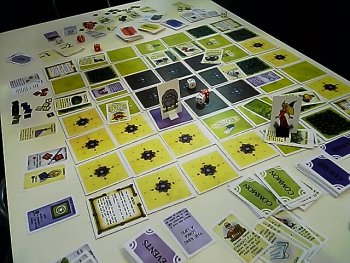 Resuming my way through the halls, I shortly stopped at the booth of VALLEY GAMES. After Container from Franz-Benno Delonge VALLEY GAMES this year once again contracted a German author, and here at Essen they now were presenting their newest building game Baumeister which was done by Wolfgang Kramer. Being attracted by the cute looking cardboard components of the game, I chose to have a short look over the rules. The players start to compete for building contract for the different buildings in the town, and once a player has been assigned a contract he is handed all pieces necessary to finish that building or piece of wall. Whereas other building games require the players to collect resources to build different kinds of buildings, Baumeister is centered on the workers as being the central resource, and thus each building piece shows rather tiny pictures which workers will be needed to finish the building. Assisted by a deck of cards, workers may fall ill, go on strike or other hazards may take place, and in the end the player who has found the right balance between closing contracts and then finishing buildings will have won the game with most points. 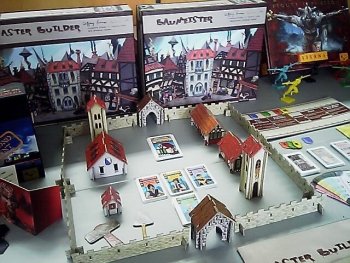 I arrived in the main halls with the major publishers a bit ahead of my scheduled meeting with a representative from ASMODEE, and so I went over to the booth of ZOCH SPIELE and luckily got a space for doing a short round of an unusual dice game. Some publishers are famous for a certain branch of games, and just like KOSMOS has positioned itself rather well with the tremendously successful Catan-series, ZOCH is ever expanding its series of Zicke Zacke chicken games with titles coming in a more or less loose collection. The latest strike in this series is Sushizock im Gockelwok which comes in one of ZOCH's small cardgame boxes, and this is the game which I chose to pass the time before the next meeting. 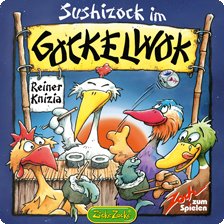 In the middle of the table two rows of 12 Sushi-portions will be placed in a random order. However, where the blue row of 12 portions contains fresh fish and offers positive values ranging from "+1" to "+6", the 12 red portions consist of fishbones and have values from "-1" to "-4". During his turn, a player now will roll five dice, and the number of blue Sushis and red fishbones show which Sushi or fishbone the active player may take. The portions is question are counted from the left of a row in rising order, but only one portion will be taken by the player. If the player does not or cannot take one portion, he will roll again with at least one dice less, and if this still does not lead to the desired result the player rolls once more, again with one dice less. All dice which were left out in consecutive rolls still will be added to the following rolls in a turn, so that a player actually has three tries to get a desired result. Once a portion is taken, the player places it in front of him so that two stacks are built: one with Sushi and the other with fishbones. All newly acquired portions go on top of their respective stacks, but it is important to notice that the players are not allowed to re-check their stacks for their contents. This rule is important because the dice do not only show portions of Sushi and fishbones, but also blue and red chopsticks which can be used to steal a Sushi or a fishbone from another player. A set of three chopsticks of the same colour allows the active player to steal a correspondingly coloured portion from the top of another player's stack, whereas a set of four or even five chopsticks gives the player a free choice which portion from a stack he wants to demand. However, since checking a stack is not possible, the active player has to make his choice by consulting his memory of the other player's acquired portions. If a roll of the dice actually leaves the active player with several options he may decide himself which options he wants to take, but if he cannot perform an action at all after the third roll of the dice he will have to take the fishbone with the highest minus-rating from the middle of the table as a penalty. The game ends when the last portion was taken from the middle of the table, and now all players align their Sushi stacks next to their fishbone stacks. Portions will be discarded until both of a player's stacks have the same height, and then each player adds up all his Sushis and substracts all fishbones. The player with the highest score has won. Although not as sophisticated as the similar sized Volle Wolle, Sushizock im Gockelwok once again displays ZOCH's knack for these small, fast paced entertainment games. With few playing materials and a tiny box a nice, tactical game for two to five players has been created, and whereas the rolling of dice certainly remains an element of high luck the players constantly are challenged to think about their current actions and (possibly) to memorize the position of important portions in the stacks of the other players. We have played with five players and here the number of different player stacks might seem confusing, but this only rests for a round since the low number of 24 included portions makes the possible memorizations rather tolerable. A nice, fast game to be played in-between two more meaty titles. 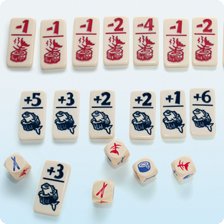 I also took a first look at the rather strange-looking game Professor Pünschge which was authored by Klaus Zoch himself and comes in one of the big gameboxes used by ZOCH. It has a colourful gameboard with a winding track of spaces numbered in increasing order, and each of the spaces is shaped in one of four different shapes, is located on of of four possible terrains, contains several recurring symbols and may be on an angled or straight part of the track. During the game, a riddle card will be drawn by one of the players, and all the riddles on the card will be based on principles which can be applied to several of the spaces on the gameboard. A simple principle would be "All spaces which are Star-shaped", whereas other principles may be "Spaces with prime numbers" or "All spaces on Woodland terrain". The player who has drawn the card will move the figure of Professor Pünschge along the track and place a token on the first two spaces to which the principle given on the card will apply, and the other players then must debate which principle might be applicable and which will be the next spaces on the track visited. They may place the Professor on the space they deem right, but if the space is not the next correct space along the track, the player of the Professor will make a meeping noise and receives a crystal whereas, the Professor stays in place. 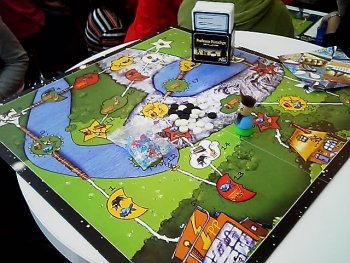 The real challenge of the game is the finding of the applicable principles, and to suit different groups of players the playing cards feature principles of five different difficulty levels. Whereas the graphics of the gameboard actually might provoke an impression that the game could be a children's game, it is certainly not suitable for children below ten years of age, and it is more suited for adults and older children. I had a go at a few cards of different levels and sometimes you really needs to think outside the box in order to get a grip on which spaces may be visited next by the grumbling Professor, but I think that the game can be really entertaining and communicative if played with a group of players which are willing to face the unusual playing concept. I asked a Press-representative, and the game probably will be available in English shortly, and so I can recommend the game for all players who like to solve some mind-boggling tasks. As I sideline, we also discussed the somewhat unusual cover of the box, and I was given the hint that the artist designed the as a somewhat ironic homage to Klaus Zoch himself, since he usually leaves his design studio in the evenings with his head full of ideas chasing each other and following some strange algorithms which may be added to new games.  The final item which I had on my fixed schedule for the convention was a meeting with a representative from the restructured distributor ASMODEE which represents a considerable portfolio of major and smaller publishers like DAYS OF WONDER, REPOS PRODUCTIONS, HURRICAN GAMES, MATAGOT or GIGAMIC. ASMODEE originally has started in France, but for the last years they had a rather strong branch office in the USA and now they had taken over all assets from PRO LUDO in Germany. The meeting was ASMODEE rather interesting due to the fact that ASMODEE takes a different view of the games market than many other publishers of distributors, seeing not only the need to design and discover good games in cooperation with smaller publishers, but also taking over a value orientated view in terms of the number of different games which should be produced and the price range in which the games should be placed. Whereas other distributors actually offer dozens of different games here at the SPIEL, the choice of games available at ASMODEE is much shorter. However, if I look back over my coverage of the previous days it is quite funny to see that a number of games which now fall under the distribution of ASMODEE have been included. This was done because I deemed these games worthwhile to be talked about, and so I can certainly see sense in ASMODEE's "quality, not quantity" approach. Seeing those games, I wholeheartedly agree to their view that a good game which has been designed to a very high standard also should be sold at a certain price, because I think that such an approach also will guarantee the production of outstanding games in the future. 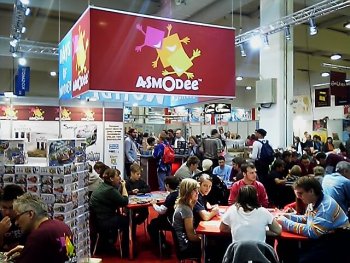 A perfect example of this new approach is the new version of the highly-popular racing game Formula D which now has been released by ASMODEE themselves, and they have put much skill and care into the game by adding new elements like instrument panels, different driver profiles, a second racing track for an illegal city race and even differently painted cars. 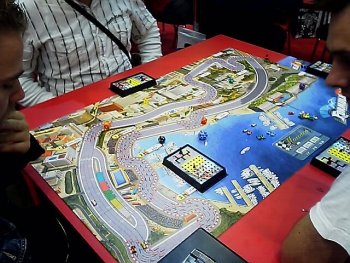 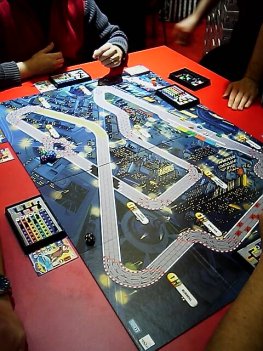 However, every race has a finishing line, and I just have seen the checkers flag which indicates that this year's reports from the SPIEL have reached the final lap. However, the nitro tank is not yet exhausted, and so gear up once more for some playtesting before we cross the finishing line. Building and construction games always have been quite popular, and especially with the release of Pillars of Earth in 2006 which later was awarded the Deutscher Spiele Preis this category of games has received another surge. Being quite fond of this category of games I was getting generally interested when I heard that a new game about building a castle was announced, and my interest rose when I heard that the game would be done by the German publisher EGGERTSPIELE which was quite successful with the economic management game Cuba in 2007. Thus, I visited EGGERTSPIELE to have a closer look at Im Schutze der Burg, the newest game by Inka and Markus Brand. 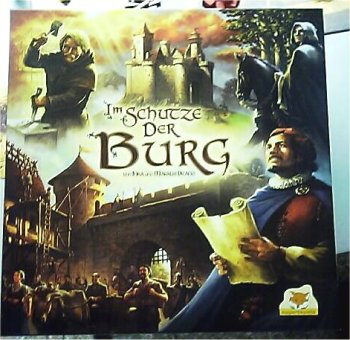 The players take up the roles of Builders who participate in the construction of a castle, and the double-sided gameboard features a huge castle in which 23 Construction plans for houses and fortifications are placed at their according spaces. During the course of the game a part of the aim of the players will be to compete to finish the most valuable buildings. The front and back of the gameboard are not used within one game, but instead the players can chose either the "Summer"-side of the gameboard to play the normal game or the "Winter"-side which will mean that some event cards will be added. Let's first have a look at the normal game, and for this each player will receive an identical hand of 8 Personality cards, 7 wooden apprentice figures, three coins, 1 sandheap and 1 wooden beam as starting resources. On the gameboard, all the four kinds of building resources (sand heaps, wooden beams, clay bricks and stone slabs) are placed at four different carts outside the building site, and an additional stockpile of silver bars likewise is placed on a mounted courier. The game is played in a fixed number of rounds, and each round begins with the players simultaneously choosing and revealing one of the Personality cards from their hand. These personalities will be dealt with in a fixed order, and if two players should have chosen the same Personality it depends on the normal player order who will be allowed to act first. The eight available different Personalities are the Messenger, the Trader, the Brick Layer, the Stone Mason, three Workers and the Master Builder, but before any Personality is allowed to act all played Workers will receive a stock of three building resources which are allocated according to the played Worker cards. Afterwards, the players will follow a specific order to act upon their Personality cards:
Both the Brick Layer and the Stone Mason have an important action in common: if their player has finished at least one building in the current round he will be entitled to place up to two of his apprentices within free spaces of finished buildings. If a required fee is paid, the apprentices will be taken in for schooling, and usually they will stay at the assigned building till the end of the game and they cannot be removed for any reason. The apprentices will bring their players victory points at the end of the game, but the amount of points scored depends on which building an apprentice was placed in. Here are some examples:
This also shows that Im Schutze der Burg contains an high element of speculation which is at least unusual for a building game. During the course of the game the players will have to make guesses how the game might end, and they will have to adjust their strategy according to the placement of their apprentices. In a way, the placement of the first apprentices in a few buildings determines a certain course for the rest of the game, since other players naturally will try to place their first apprentices in other buildings so that a competition and conflicts arises to build the most profitable buildings before the game is over. However, real conflicts are prevented by the fact that no destructive rules exist, and so each player will focus in honing his strategy of constructing fitting buildings and placing his apprentices at the right time. Early placements will fix a player to a certain strategy and reduce the number of apprentices which can be sent to gather new resources, whereas later placements keep the danger of other players occupying the desired buildings. This keeps the outcome of the game refreshingly unpredictable, since most players certainly do not want to keep calculating all the time. To my mind this also makes the game a good family game, precisely because the outcome is open and competition remains high till the end. With the Winter-side of the gameboard a variant game has been included which differs because of the event cards which will be drawn in some rounds. These event cards offer interesting variants to the existing gameplay, like the tavern in which an apprentice can be placed to force all players who use the Trader to give one coin to the player with the apprentice in the tavern. Another example is the Damsel of the Castle which can be courted by the players, with each player who wants to stay in the competition for the Lady's hand to place one coin or resource at her card in each turn. If all but one player have dropped out of this contest the final player will win the Lady's hand (and 8 victory points), whereas all other players are allowed to share the Damsel's dowry between them. However, if more than one suitor remains at the end of the game, nobody will get the additional victory points. Being more fond of adventures than calculations, I really liked this variant game which spiced up the gameplay with a some unexpected turns. While it is true that there is a certain factor of luck associated with these cards, I think that the whole playing atmosphere greatly profits from their use. Peter Eggert also has thought of a nice bonus for players who purchase the game directly from his booth here at the convention, since all players who get the game directly from him will get an additional set of six more, different event cards. A good tactics for a small publisher to boost up sales without actually grabbing deeper into a purchaser's wallet. Overall, Im Schutze der Burg is not as complex a game as last year's Cuba, but to my mind the somewhat unusual gameplay and the good playing atmosphere make the game quite recommendable. 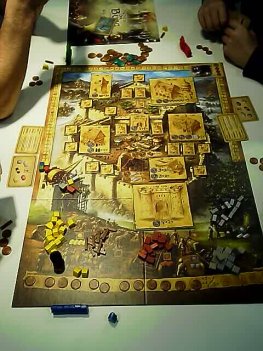 With the afternoon wearing on, I still had to collect our International Gamers Awards banners from the booths of ours winners to store them for next year. I first visited Zev Shlasinger at his booth of Z-MAN GAMES, and I also asked him a few details about the current schedule for the new release of Tales of the Arabian Nights. He told me that it was not yet available because the paragraph booklet was not finished yet, and this was due to the reason that they had taken the booklet of the revised German edition by ERLKÖNIG as a basis, but they were adding about another 1000 paragraphs in order to include even more kinds of possible actions. The new paragraphs were close to the original stories, and so the development stage just had to be finished. Zev estimated that the game finally would be available in February 2009. 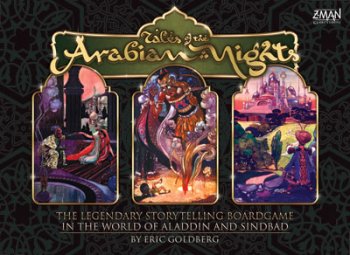 Being too short on time for a thorough playtest, I nonetheless stopped at the big playing area of LOOKOUT GAMES to get a quick introduction to Uwe Rosenberg's newest and much awaited game Le Havre. This game takes the players through the industrialisation process of the French harbour town, and it will be their aim to profit most by the clever use of resources, buildings and ships. At the beginning of a player's turn the players have a chance to get some resources which are available at different quays in the harbour. The resources available for free taking are raw materials like metal, fish, grain or cattle, but during the game players may use special buildings in order to refine them into some more valuable assets like steel, smoked fish, bread or butchered meat, and apart from being turned into money or being used as payment for the construction of certain buildings the edible resources also will be needed at the end of a turn when the players must pay an ever increasing upkeep in food in order to avoid a penalty. Instead of gaining resources the players also may opt to act in one of the buildings available in the town, and these actions allow a quite diverse choice of special moves like the desribed refining of raw materials, the gaining of additional materials, or the trading of materials. At the beginning of the game three basic buildings are available and they belong to the city council, but these buildings actually may be acquired by a player and quite a few additional buildings will be either built or purchased during the course of the game. Also, some of these buildings actually cannot be entered by the players during their action phase, but instead buildings like the Bank or the Docks will increase their final value at the end of the game if certain conditions are met. So, the Bank will get more valuable with each industrial building which is constructed in town, whereas the Dock increases its value by each of the player's ships. In addition to the two possible actions outlined above a player also may chose to buy and sell or build buildings and ships. Buildings are available in three open stacks on the gameboard, whereas new ships which can be built are revealed by the end of a round of play. The actions available in the buildings owned by a player may be preformed by any player who places his token there during his action phase, but the owner of the building actually will receive some royalties for its use. The ships on the other hand are very important on the long running, since they increase a player's food allowance by the end of the turn so that the upkeep costs can be reduced on a permanent basis. Variation between the games is reached by the use of a special Building stack from which only six cards will be revealed each game, and thus the players always will be faced with some new building actions which they must integrate in their long running strategies. Futhermore, several minor rules like the automatic increase of grain and cattle in the harvest time, the slow arrival of ever increasing ships or the construction of additional buildings by the city council leave an impression of the passing of years and add playing depth and atmosphere alike. The rules of Le Havre actually are much shorter than the rules of Agricola, but I somewhat got a feeling that the depth of the simulation reached in the game is more pronounced than in its predecessor. Quite a few buildings are available which should not be underestimated in terms of the correct use of their special actions, and most of these buildings will appear anyhow so that the character of the game and the player's strategy is not depending on a hand of cards which is drawn in Agricola right at the beginning. However, this does not mean that Uwe Rosenberg hasn't put all possible effort in the game, and so the game features all needed adjustment rules to be played either in solitary mode or in special shortened games if the players are short on time. I rather liked the general impression I got while doing this short introductory round, and I am looking forwards to give the game some more testing after the convention has finished. 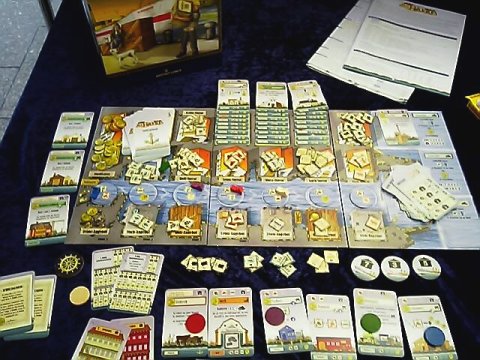 Afterwards, I went to the booth of LOOKOUT GAMES to collect our banner and to say goodbye to Melissa Rogerson, but she actually surprised me with a quite attractive addition for our prize draw! Prize-Draw enhanced even more!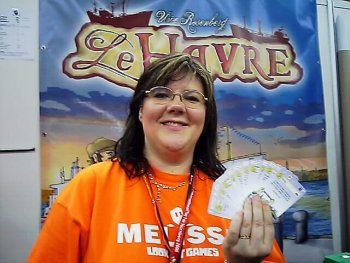 Melissa actually gave me a full set of the 12 different Le Havro promo cards which were available only here at the show. And even better, it is an ENGLISH SET. Also, as a final add-on I will throw in an international copy of Chicago Express by Queen Games, the successor of the famous train-game Wabash Cannonball. All this can be won by signing my SPIEL Guestbook ! Please note that I am going to keep the Prize Draw open until Friday the 31st of October, and the winners will be displayed here at the following weekend! Kulkmann's Convention Hit 2008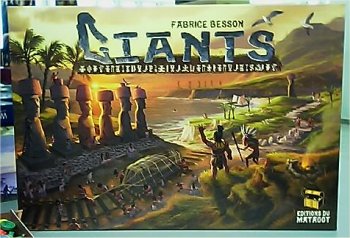 As is tradition, I will give my special recommendation of one of the games I have played during this convention, and once again I am hard pushed to decide between several candidates. My favourites are Space Alert, Im Schutze der Burg, Giants and Ghost Stories, because all of them have convinced me with really nice playing mechanisms and a very good design. All of them are candidates which should be given special attention, but in the end I have decided to call Giants my personal Convention Hit of the SPIEL 2008. To my taste, the game has been developed to a degree of perfection which simply cannot be topped. The rules are not too complicated but offer good possibilities for individual tactics, and the design of all components simply does not fall short of perfection. Even small components like the symbolic overview tables behind the player screens are well designed and an invaluable assistance to novice players, and coupled with the great artwork and the beautiful playing pieces Giants makes up a rather unique, extraordinary game which can be enjoyed by families and hobbyists alike. I made a final visit to Jussio Autio from TUNOELA, because I had missed the opportunity to playtest two of his prototypes, but I will be back with TUONELA next year when the rather fascinating game Modern Society which I had seen as a prototype in 2007 will be released. 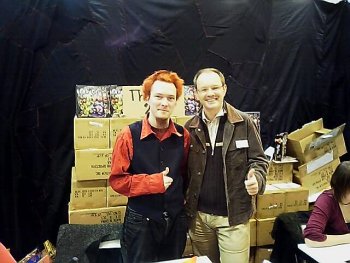 And here we are, right at the end of my reports from the SPIEL 2008. The convention has closed its gates at 6 PM and it is now 1:24 AM as I am typing those final lines, but once again it has been a great show and I can harly remember a SPIEL which has been filled with so many good games as there had been this year. Looking next to my desk, a considerable pile has grown there, and I am just happy that I had to carry all these games for 200 meters in order to get them home, whereas all visitors will have to carry their haul much further. 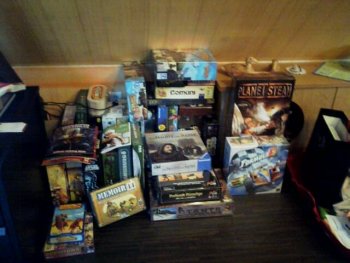 Anyhow, at this place I would like to thank all of you for reading about my experiences at the SPIEL 2008, and my special thanks goes to those of you who have visited my Guestbook and left all these wonderful commentaries. To carry on with a project like this for a whole week is rather tiresome, and I am more than delighted to see how many people actually are fond of the service I provide. This is rather important for me, since it gives me enough motivation to keep the whole thing going! So, if there are any final comments left on your side, let me know either through the Guestbook or via good old email! As the old saying goes "Same time, same place!", I hope to meet all of you back here next year. Myself, I will be going back to my office on tuesday, and I will be be thinking back to the great time at the SPIEL 08 when I am going to playtest my way through the pile of new games . My wife actually eyes them with some kind of scepticism, but I guess she just needs a bit persuasion before learning just a few new rules.... See you all next year!!!! Frank Schulte Kulkmann from Essen, Germany (Signing off to get sleep at last!!!!) If you want to have a peek at my coverage of previous conventions, follow these links:
Opening timesFrom thursday to saturday the convention is opened from 10 AM until 7 PM, on sunday from 10 AM to 6 PM. Travelling to the Messe EssenIf you arrive at Düsseldorf International Airport, it takes about 20 minutes to get to the Messe Essen by Cab. If you hire a car at Düsseldorf Airport, you go onto Autobahn A44 (blue signs), and at the next motorway crossing you go over to A52, direction Essen. Take Exit "Essen Rüttenscheid". You can also go by train to Essen Central Station. If arriving there, go to the basement and take the Subway U11 directly to the Messe Essen. If you want to arrange lodging at Essen, you best contact the Essen-tourism-center by phone 0049/(0)201/19433 or 0049/(0)201/88720-46 or -48. Perhaps they know where some Hotel-rooms are left... |
|
| |

Looking for the new games? Visit Funagain Games! |
|
|
| |
|
Kulkmann@aol.com
Copyright © 2008 Frank Schulte-Kulkmann, Essen, Germany | |